2019年3月4日(月)17:20-18:20
異分野間恊働懇話会(主催:日本心理学会若手の会) アピカルイン京都
動物心理学から錯視の研究へ
立命館大学総合心理学部 北岡 明佳 email
2019/3/2 より 配布物
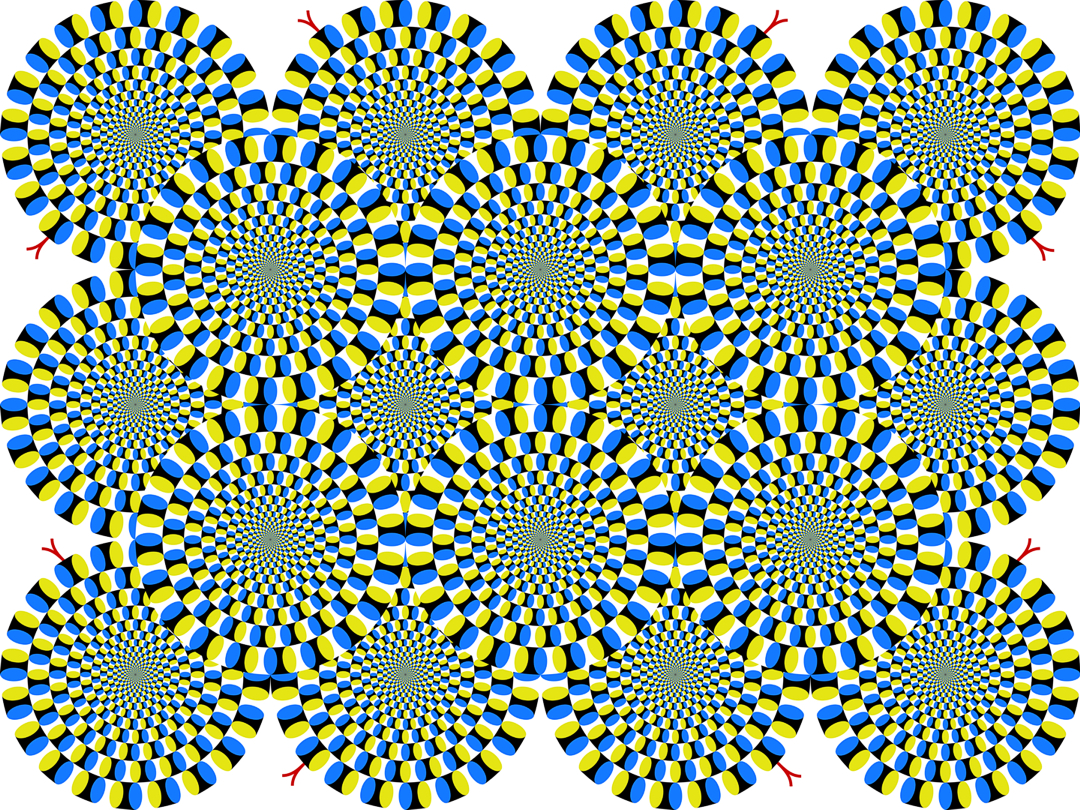
「蛇の回転」
円盤がひとりでに回転して見える。2003年の作品。錯視としては、最適化型フレーザー・ウィルコックス錯視。ウェブサイト「北岡明佳の錯視のページ」(Akiyoshi's illusion pages)に掲載したところ、人気を博した。なお、2001年4月に、北岡は、東京都神経科学総合研究所から、立命館大学文学部に転職した。
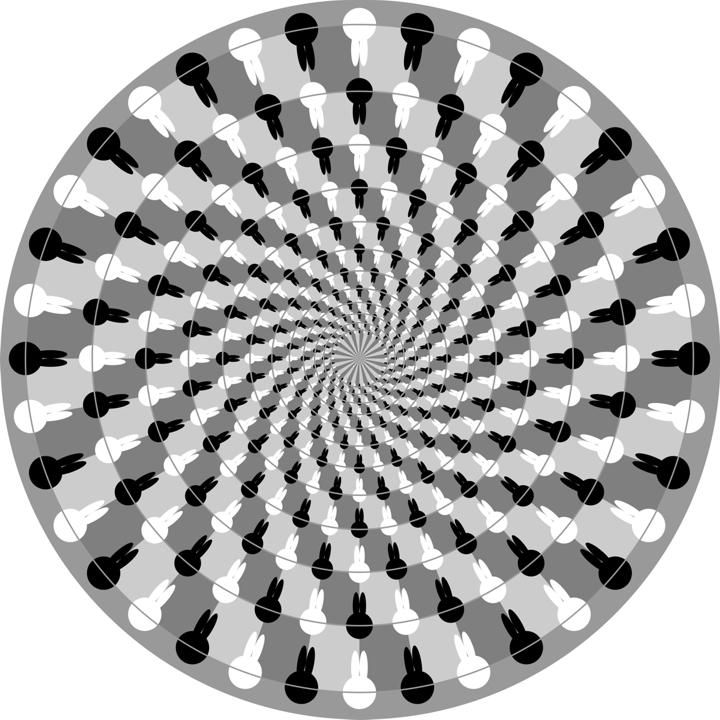
「卯図」
灰色の同心円が左に回転して中心に向かう渦巻きに見える。平成11年(1999年)の年賀状用デザインとして作成(1998年の作品)。年賀状デザイン
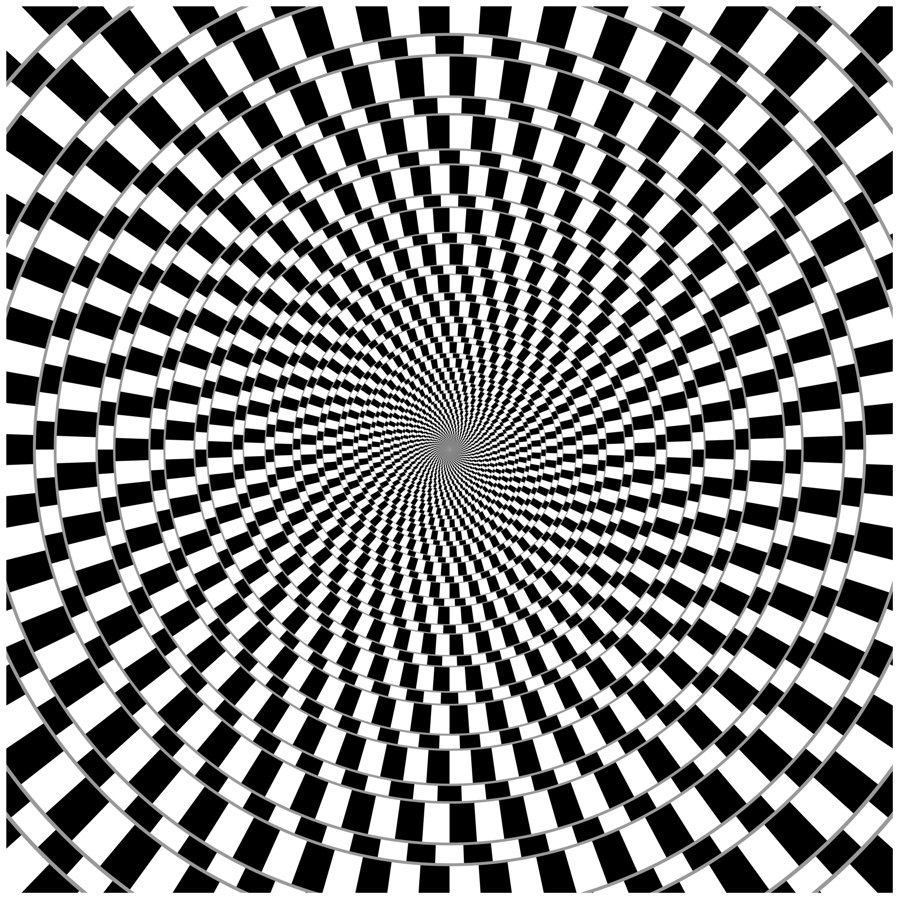
カフェウォール錯視(ミュンスターベルク錯視)の渦巻き錯視
灰色の同心円が右に回転して中心に向かう渦巻きに見える。
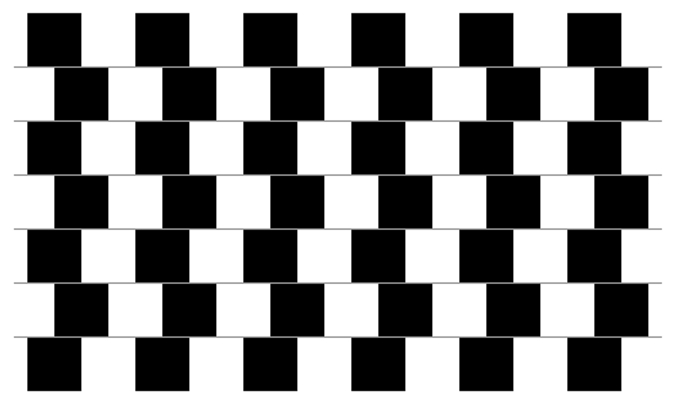
カフェウォール錯視(ミュンスターベルク錯視)
灰色の平行線が、上から左・右・左・右・左・右に傾いて見える。
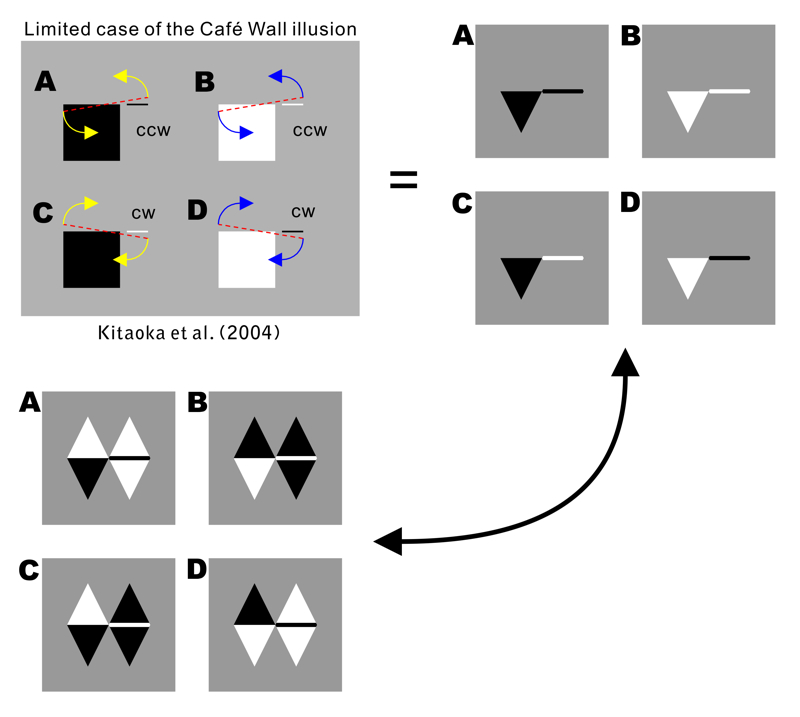
カフェウォール錯視(ミュンスターベルク錯視)の基本4要素
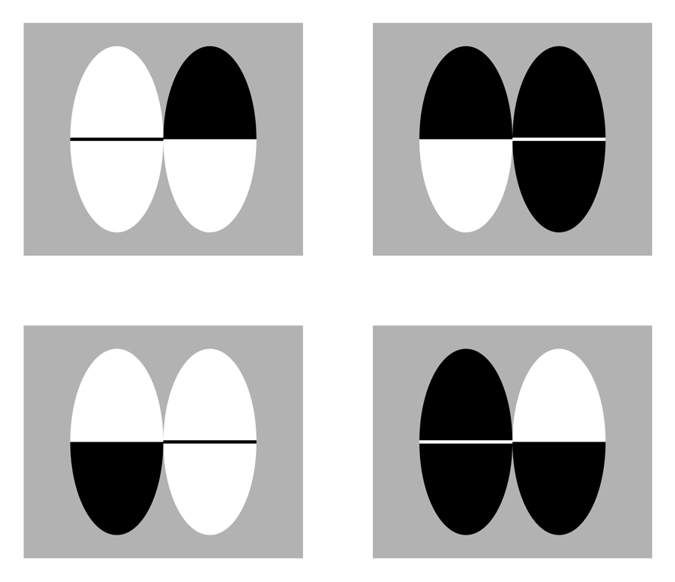
カフェウォール錯視(ミュンスターベルク錯視)の基本4要素
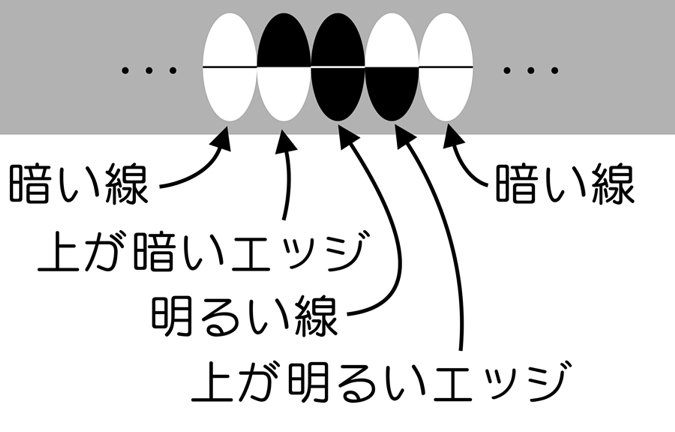
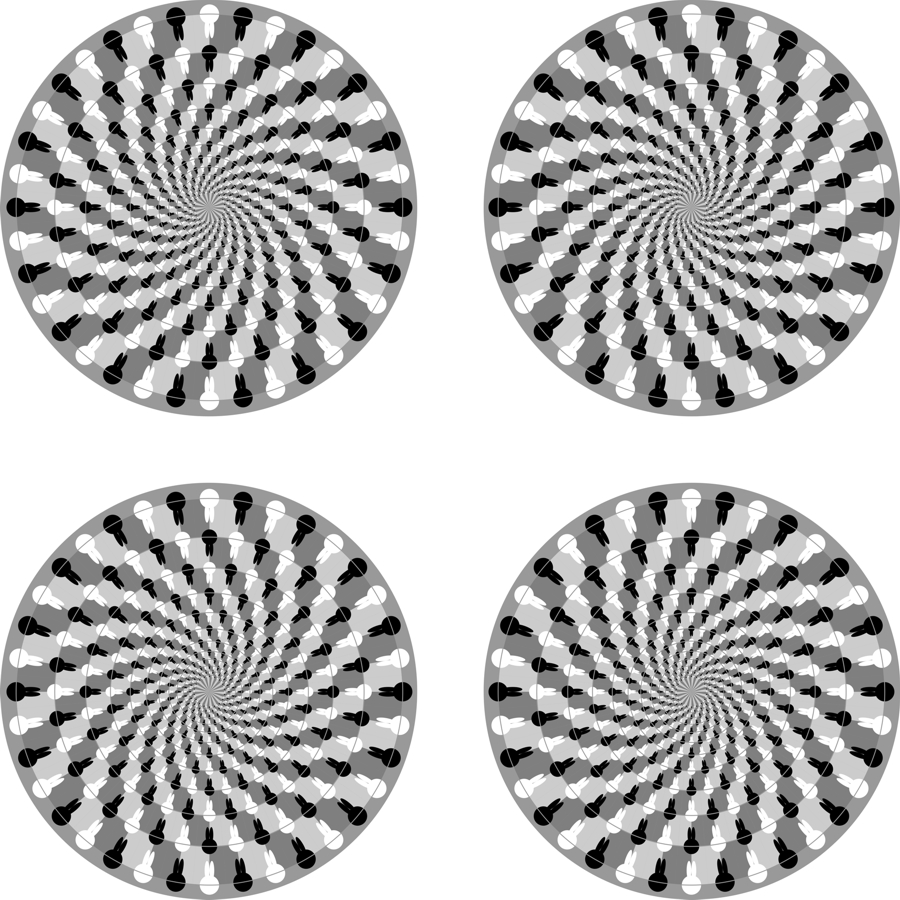
「卯図」
(リメーク版)
円盤が回転して見える。
Copyright A.Kitaoka 2019 (March 2)
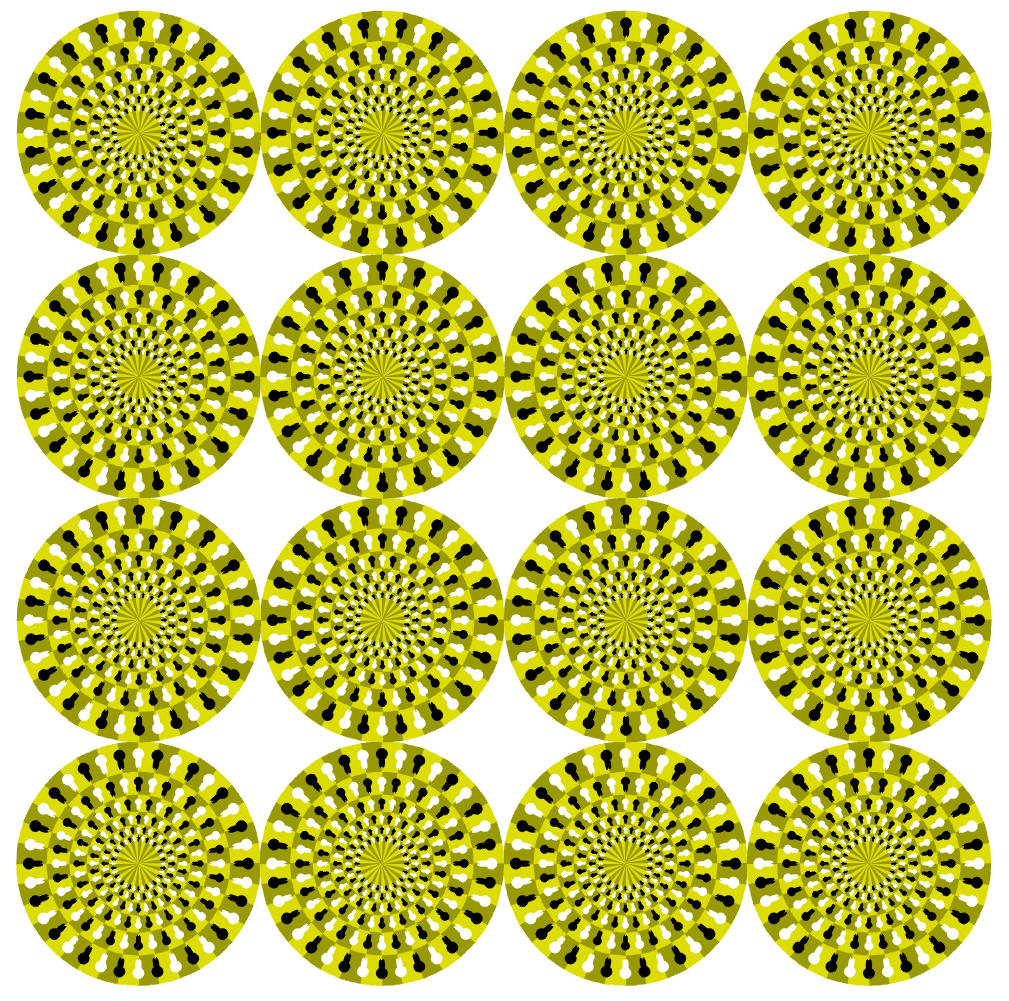
「卯図巻き」
Copyright A.Kitaoka 2003
(c)北岡明佳 2003 「トリックアイズ2」 (カンゼン刊)
円盤が回転して見える。
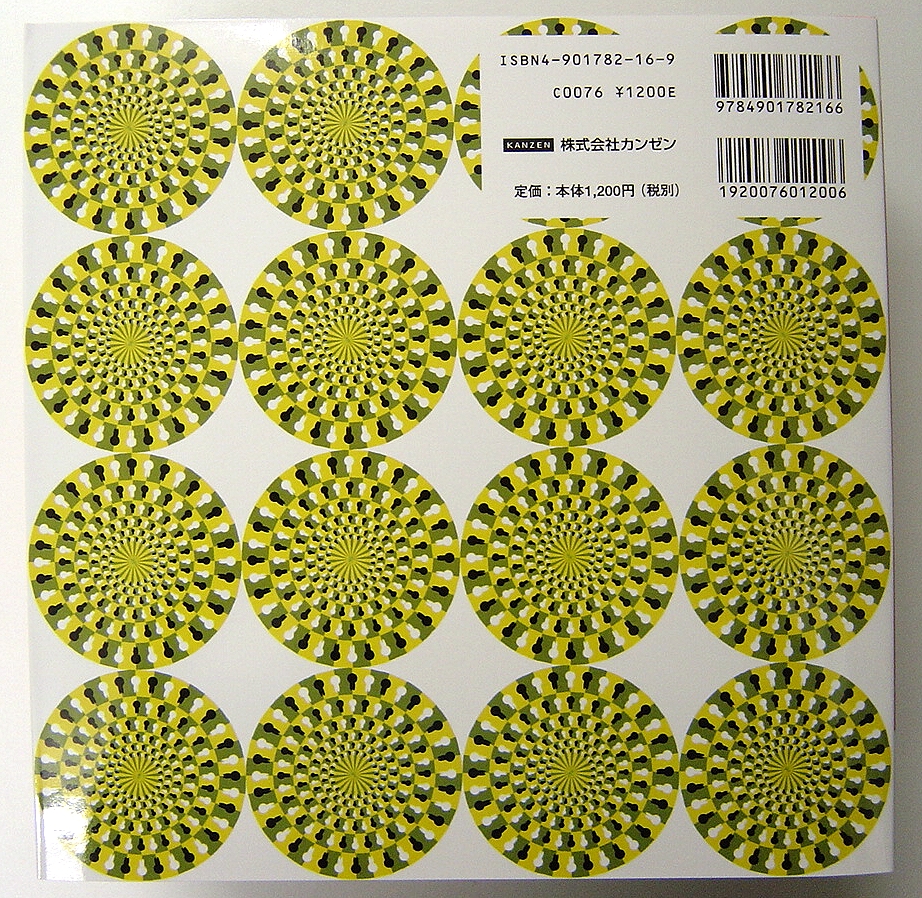
北岡の錯視本第2弾(2003年刊行)の裏表紙
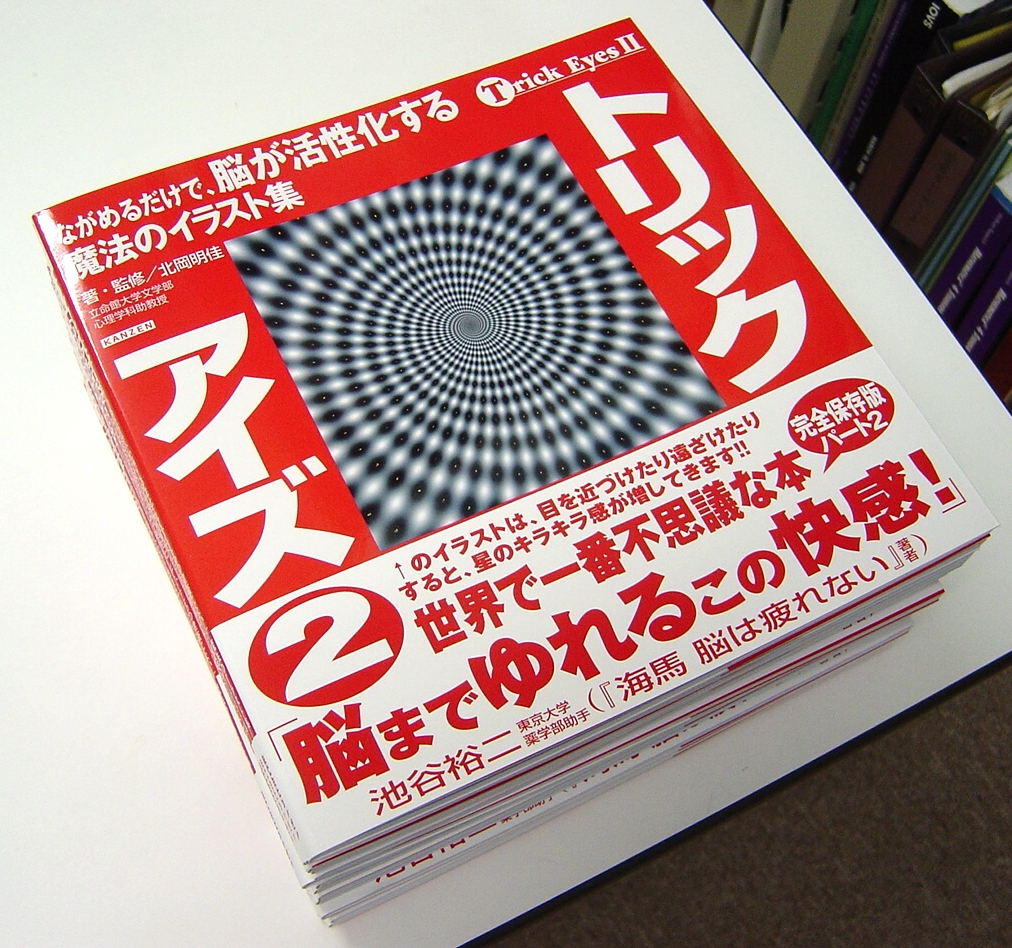
北岡の錯視本第2弾の表紙
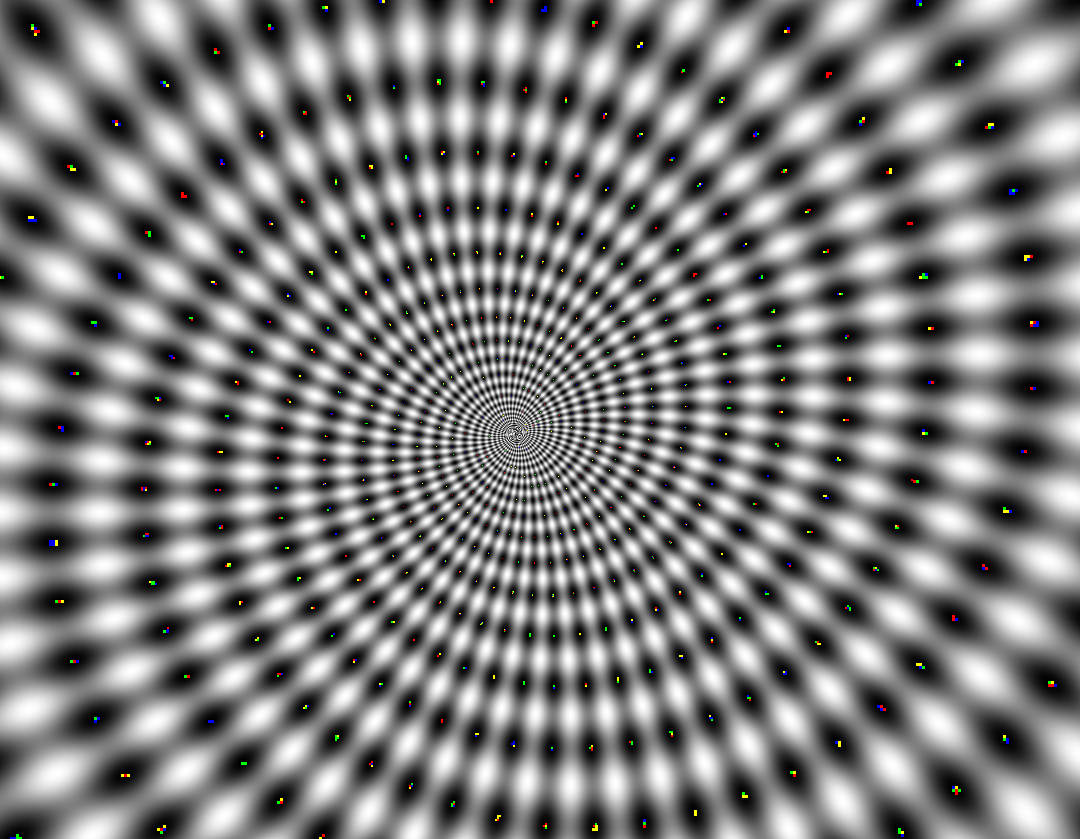
「ワープ」
色の粒がきらきらして見える。2003年制作。Delphi でプログラミングをして作成。なお、多くの作品は、CorelDRAW を用いて作成されている。
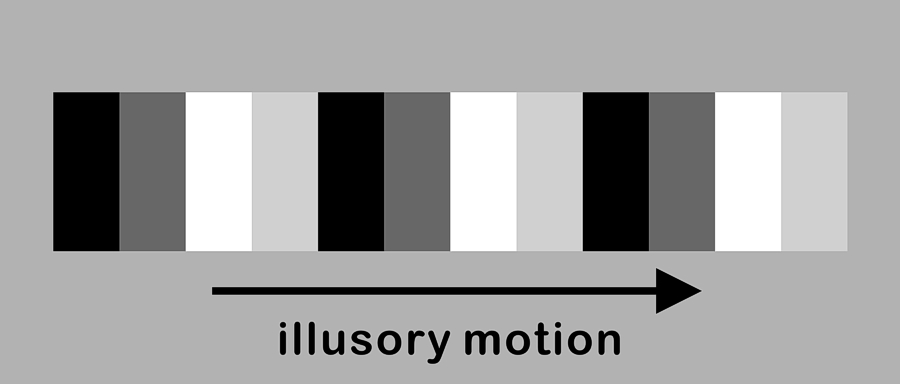
「卯図」の錯視的動きの方向
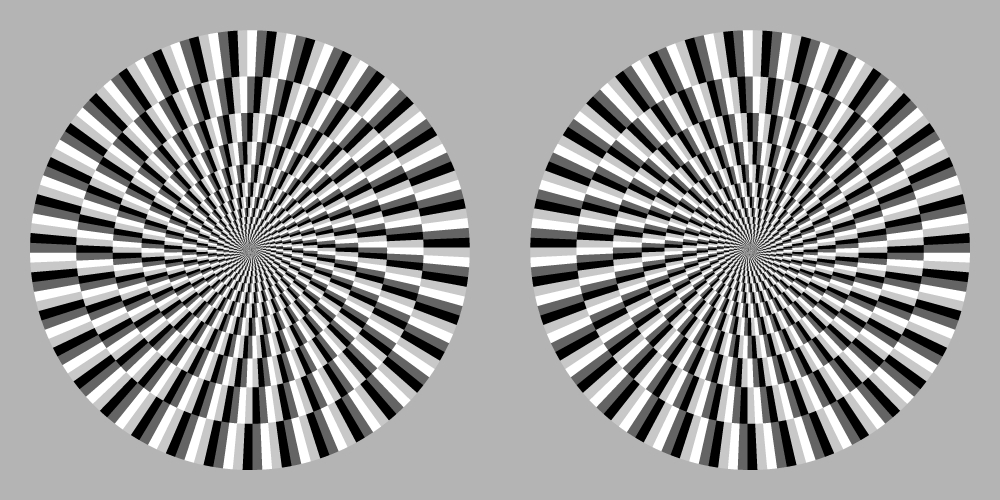
The left disk appears to rotate counterclockwise while the right one clockwise. Kitaoka and Ashida (2003) proposed that the illusory motion is strong when patterns are arranged in the following luminance order: from black, dark-gray, white, light-gray, and back to black.
References
Kitaoka, A. and Ashida, H. (2003). Phenomenal characteristics of the peripheral drift illusion. VISION (Journal of the Vision Society of Japan), 15, 261-262. PDF
1. Fraser and Wilcox (1979)
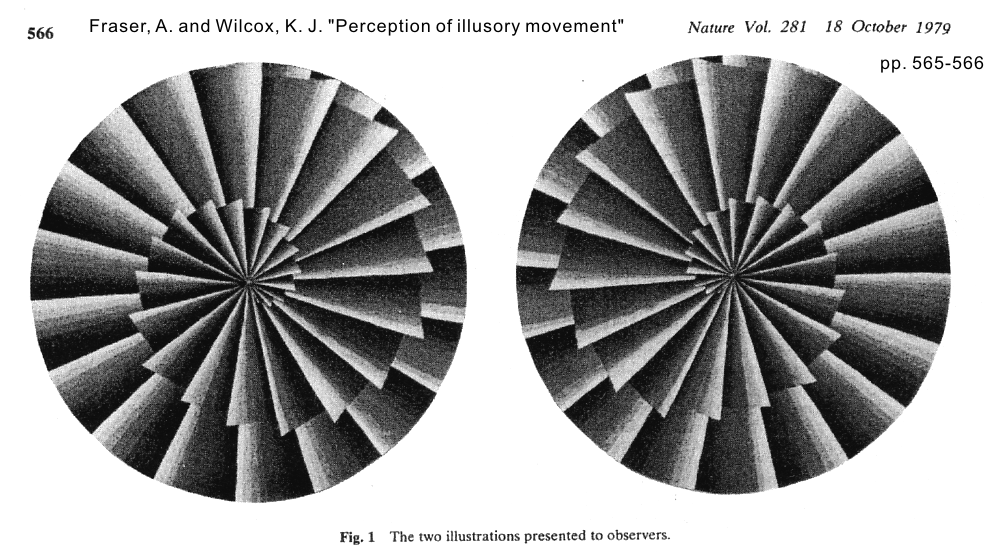
References
Fraser, A. and Wilcox, K. J. (1979). Perception of illusory movement. Nature, 281, 565-566.
Observers saw illusory motion in a stationary image which consists of repeated luminnace gradient in a saw-tooth wave form. Some reported illusory motion from dark to light along a luminance gradient, while others saw the reversal. The illusion is strong in the peripheral viewing. Fraser and Wilcox (1979) claimed that this individual difference depends on some genetic properties.
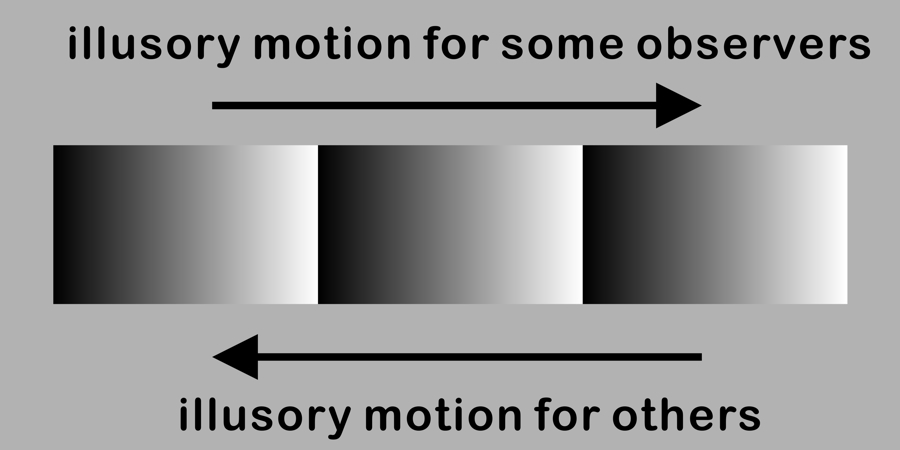
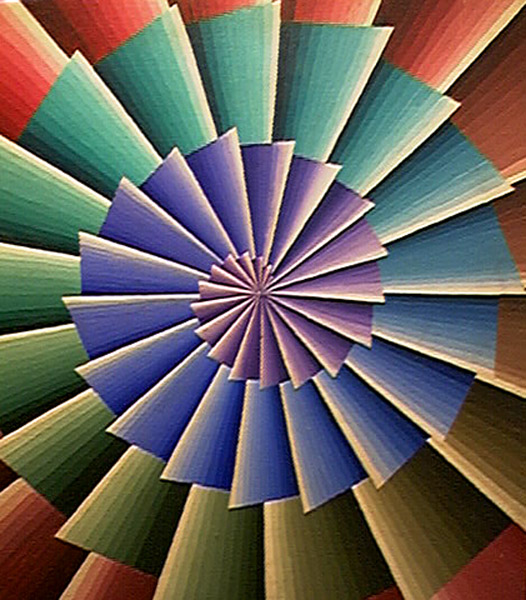
Adopted from “Alex Fraser, Geneticist and Painter”
(http://doctoralexfraser.blogspot.jp/p/spirals.html) <access August 25, 2012> (with permission from Alan Fraser)
Alex Fraser (1923-2002) was a geneticist and a painter.
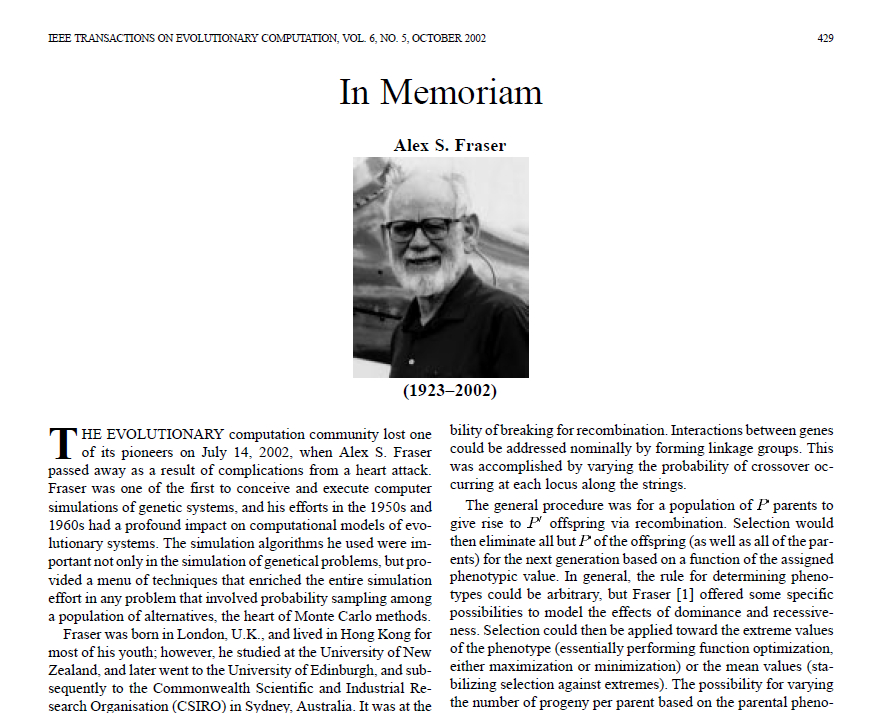
Fogel, D. B. (2002). In Memoriam: Alex S. Fraser (1923–2002). IEEE Transactions on Evolutionary Computation, 6(5), 429-430.
2. Faubert and Herbert (1999)
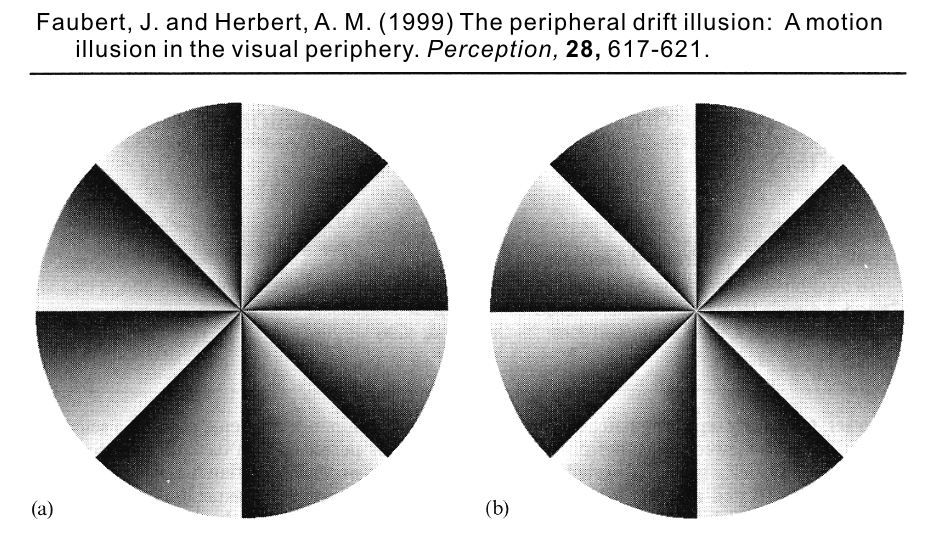
The left disk appears to rotate clockwise while the right one counterclockwise. Faubert and Herbert (1999) reported only illusory motion from dark to light along a luminance gradient. They attributed the illusory motion to the assumed time difference between responses to black and white.
References
Faubert, J. and Herbert, A. M. (1999). The peripheral drift illusion: A motion illusion in the visual periphery. Perception, 28, 617-621.
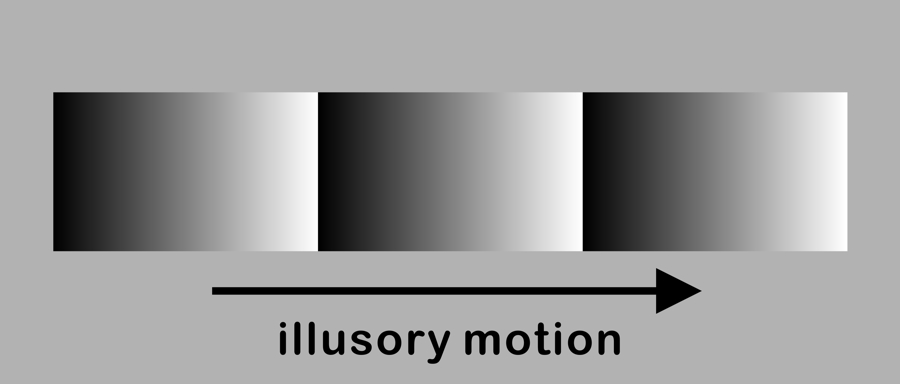
3. Naor-Raz and Sekuler (2000)
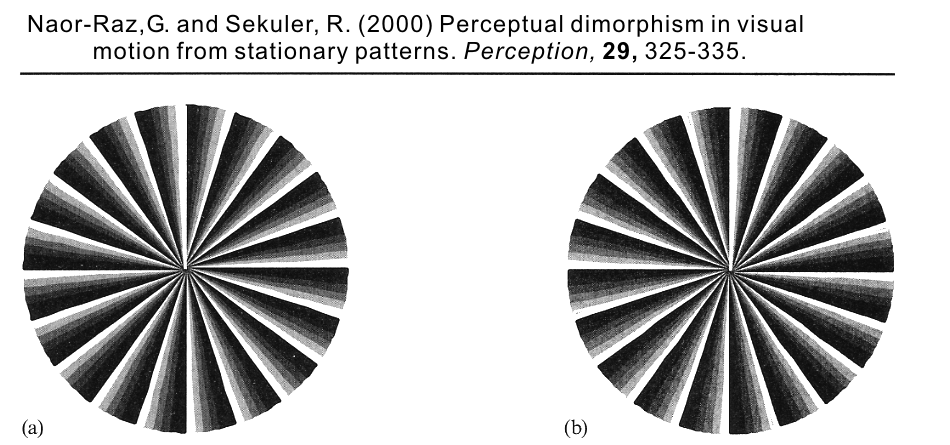
The left disk appears to rotate clockwise while the right one counterclockwise. Naor-Raz and Sekuler (2000), too, reported only illusory motion from dark to light along a luminance gradient. They revealed that the illusion magnitude is a positive, nearly linear function of contrast.
References
Naor-Raz, G. and Sekuler, R. (2000). Perceptual dimorphism in visual motion from stationary patterns. Perception, 29, 325-335.
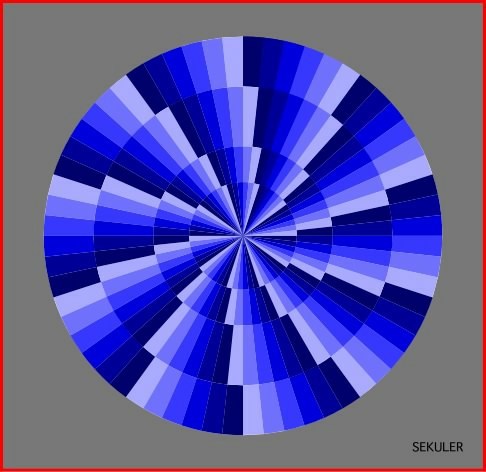
This disk appears to rotate clockwise.
This color illusion image presented by Naor-Raz and Sekuler (2000) (shown
below) might be attributable to this type.
http://www.perceptionweb.com/perception/perc0300/sekuler.jpg <access August 26, 2012>
<with permission from Robert Sekuler>

Kitaoka (2007) classified the Fraser-Wilcox illusion into Type I, IIa, IIb and III, in each of which the dark-to-light type was distinguished from the light-to-dark one.
References
Kitaoka, A. (2007) Phenomenal classification of the “optimized” Fraser-Wilcox illusion and the effect of color. Poster presentation in DemoNight, VSS2007, GWiz, Sarasota, Florida, USA, May 14, 2007.
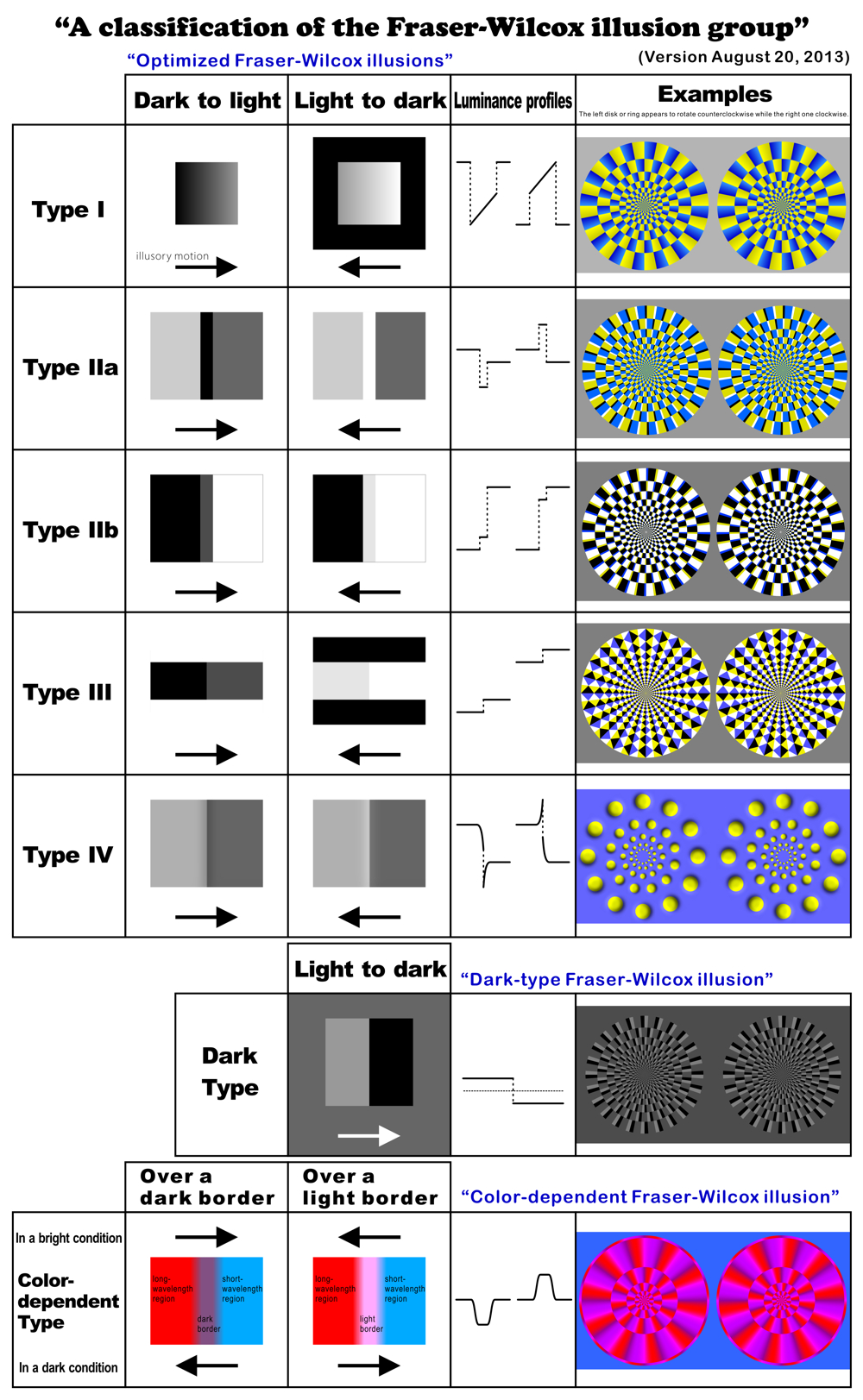
Type I

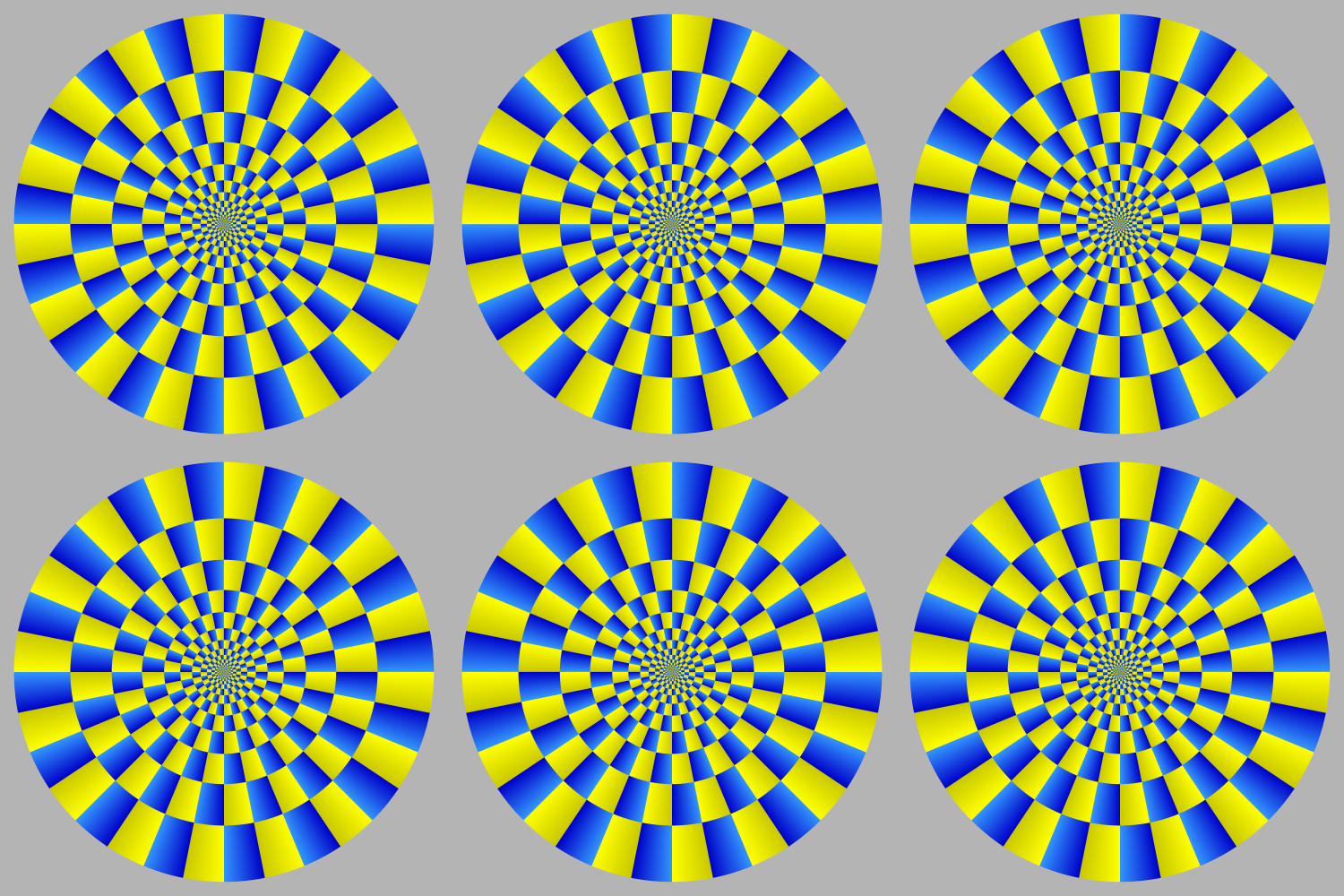
The upper-left, upper-right, and lower-middle disks appear to rotate counterclockwise
while the rest clockwise.
Type II
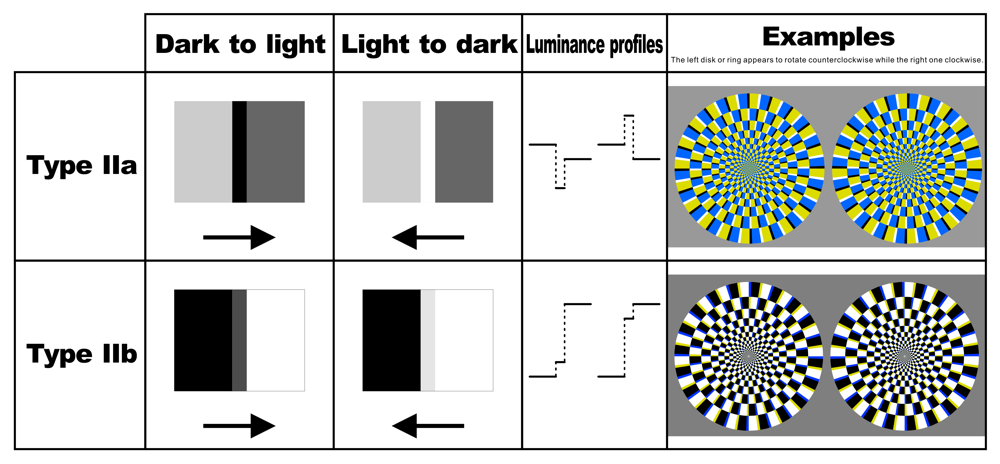
Type IIa
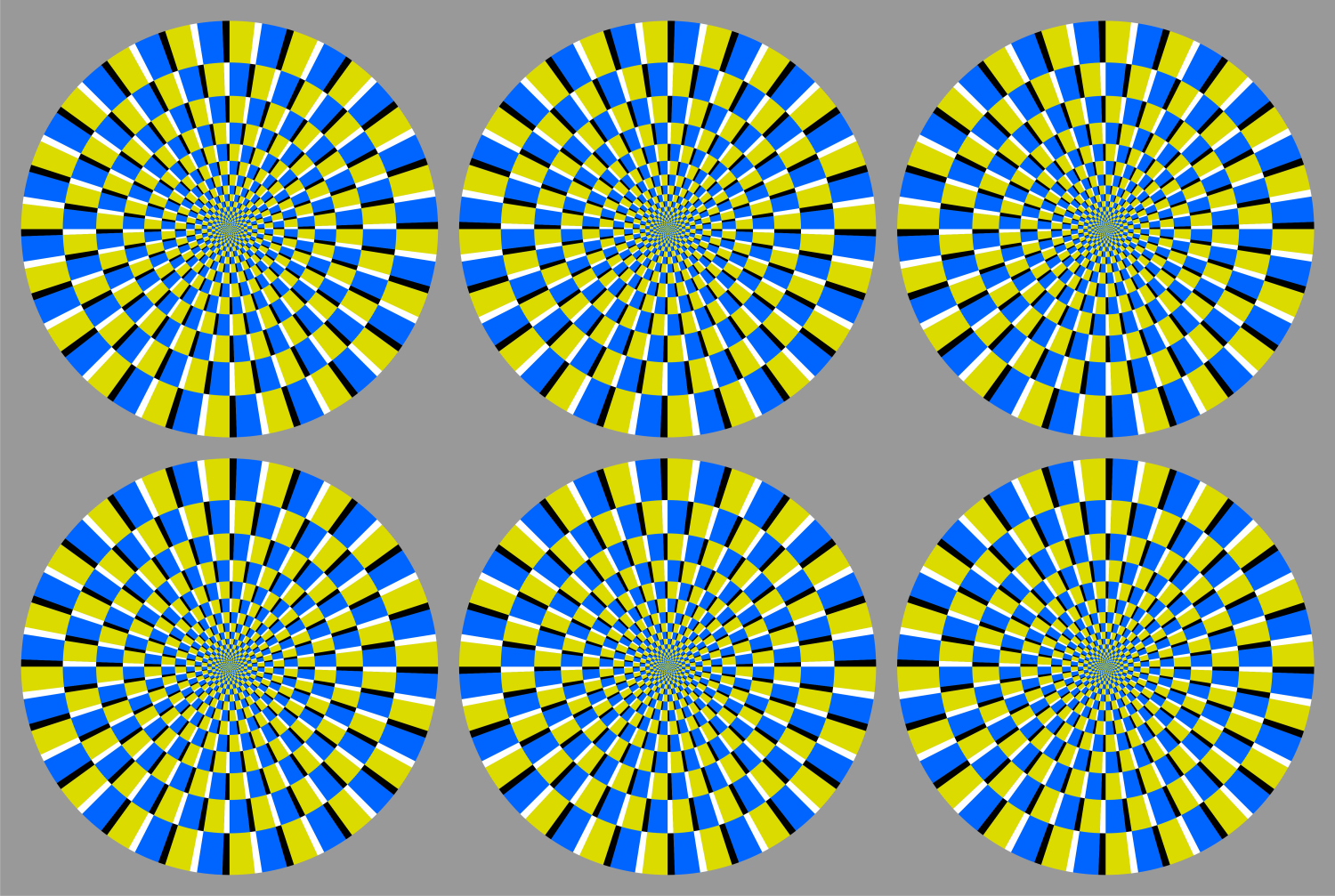
The upper-left, upper-right, and lower-middle disks appear to rotate counterclockwise
while the rest clockwise.
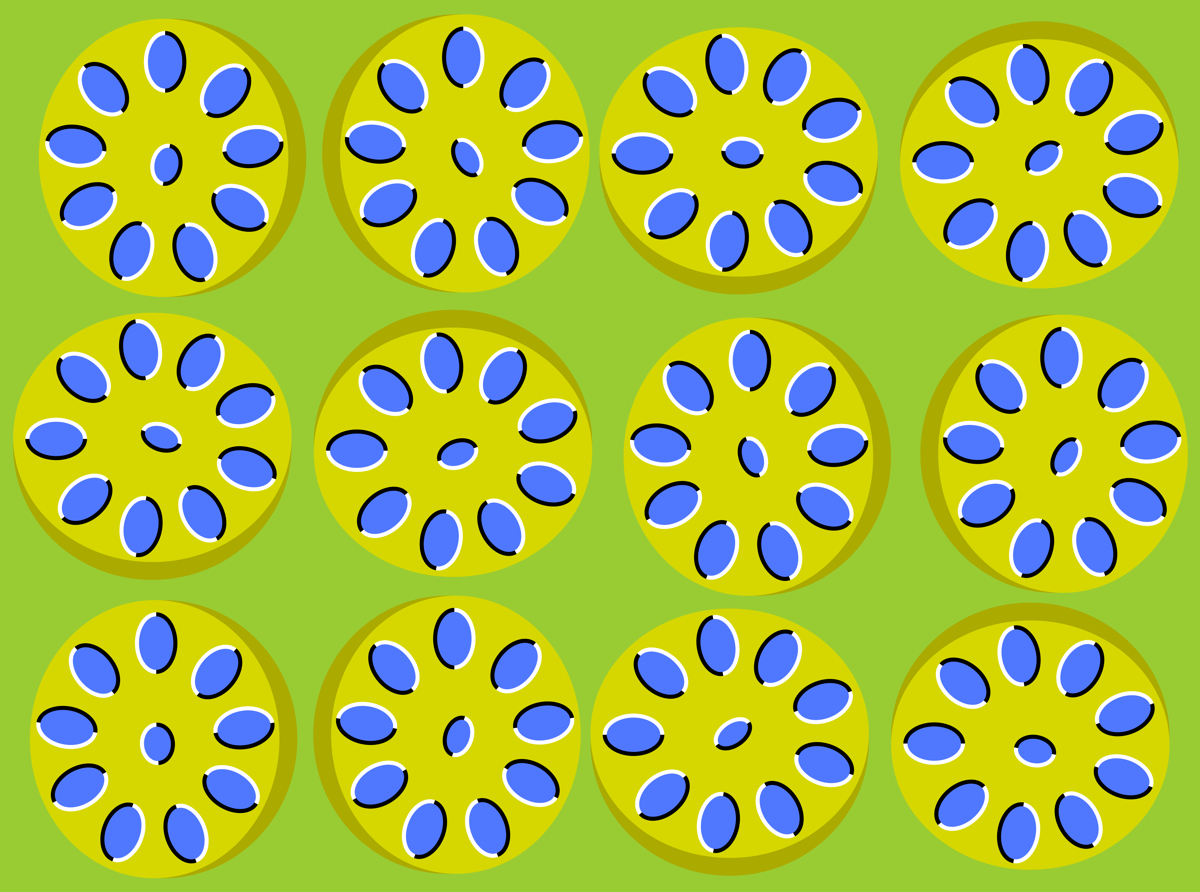
「れんこんの回転」
れんこんが回転して見える。
Copyright Akiyoshi Kitaoka 2012 (November 23)
岩国名物だとか。
「れんこんの回転」(最適化型フレーザー・ウィルコックス錯視・タイプIIa)の作り方
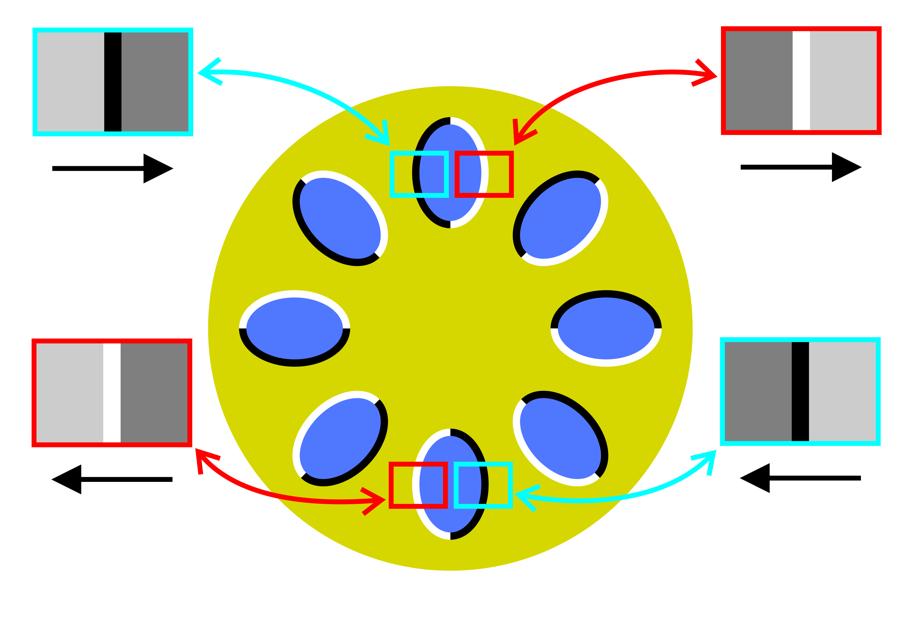
Type III

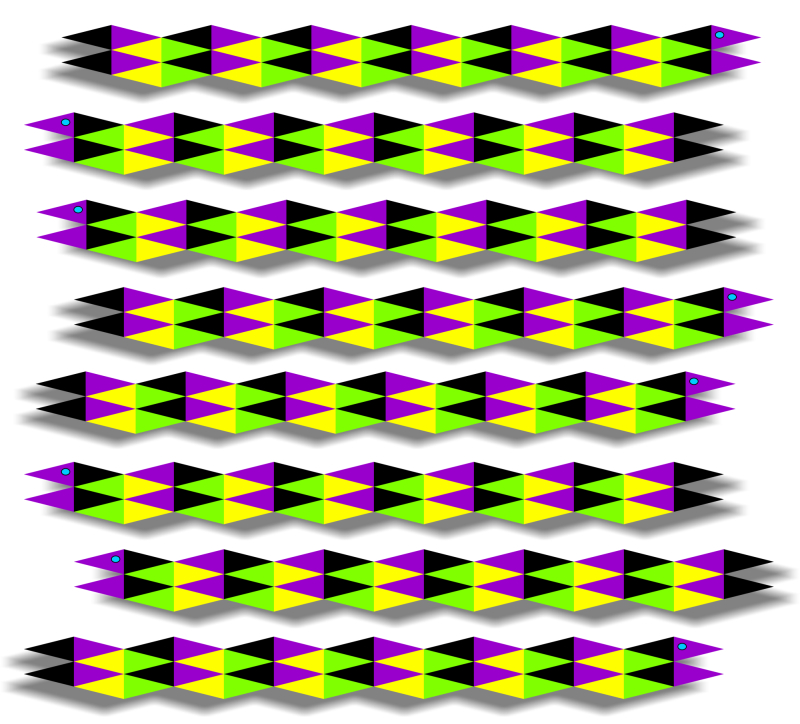
「影付きの左右に動く蛇」
蛇が左右に動いて見える。
Copyright Akiyoshi Kitaoka 2009 (June 7)
6. Kitaoka (2008a, b)
"Type IV" was added to the list.
References
Kitaoka, A. (2008a). Optimized Fraser-Wilcox illusions: a pictorial classification by Akiyoshi Kitaoka. Talk in Workshop No.005 "Experimental studies of anomalous motion illusions" in the 72nd Annual Convention of the Japanese Psychological Association, Hokkaido University, Sapporo, Japan, September 19, 2008. Talk
Kitaoka, A. (2008b). A new type of the optimized Fraser-Wilcox illusion in a 3D-like 2D image with highlight or shade. Journal of Three Dimensional Images (Japan), 22(4), 31-32. PDF PDF (manuscript) Presentation
Type IV

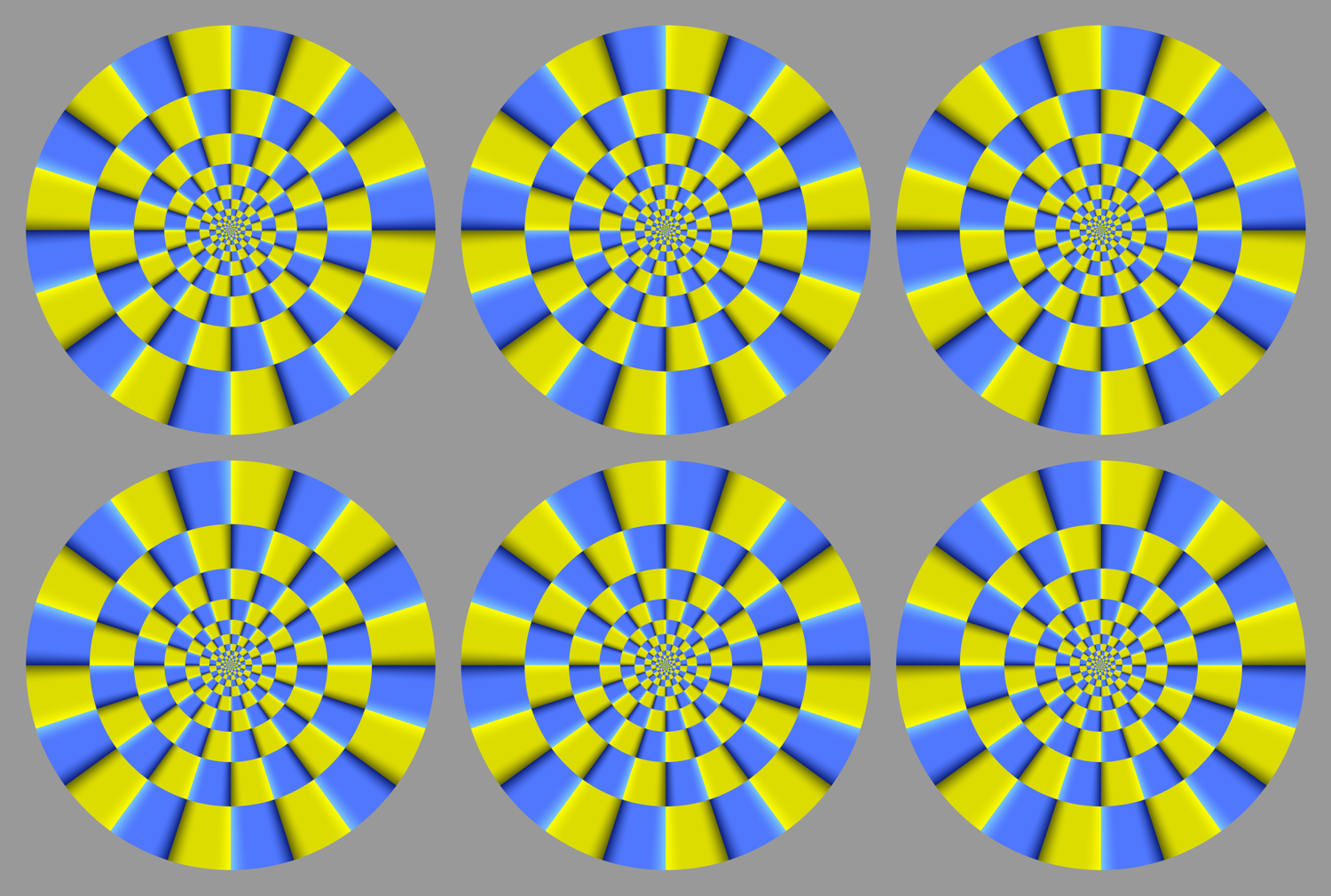
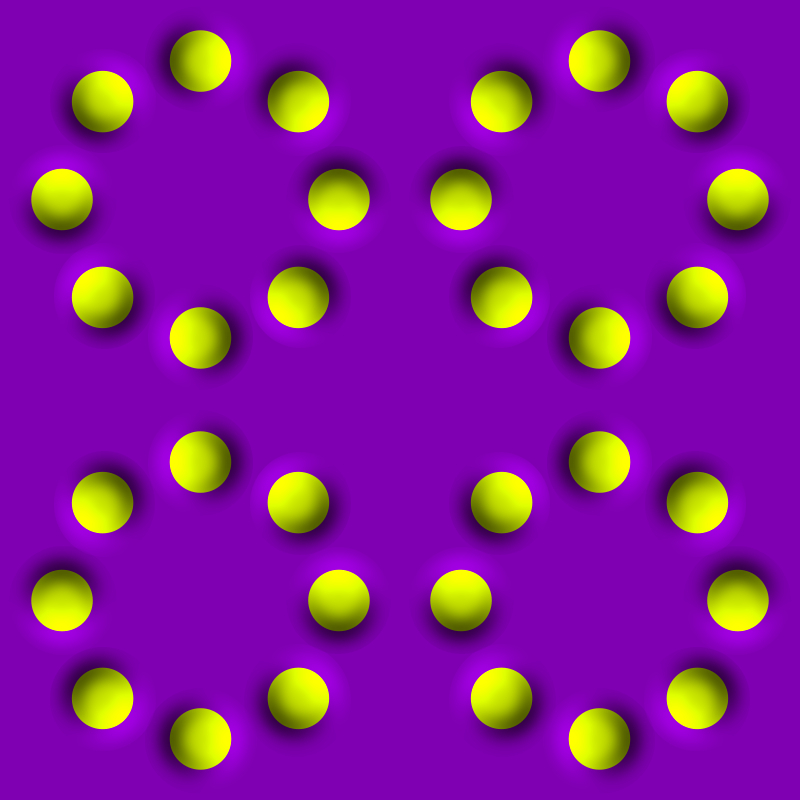
"Rotating tablets"
Rings appear to rotate.
Copyright Akiyoshi Kitaoka 2011 (July 14)
色依存のフレーザー・ウィルコックス錯視
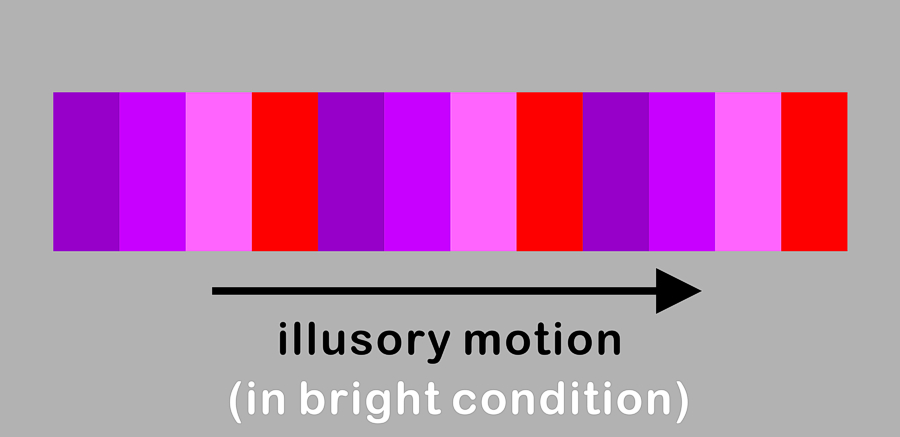
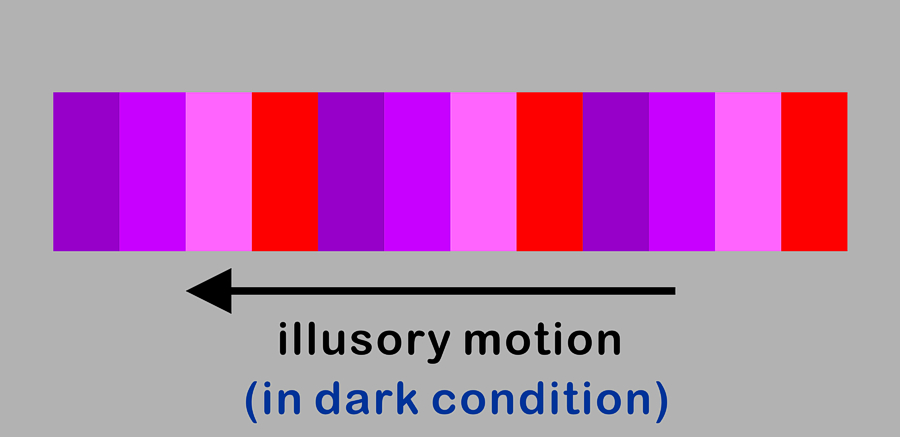
Black » dark-gray » white » light-gray » black
Purple » light purple » light red-purple » red »
purple
References
Kitaoka, A. (2010). Introduction to visual illusion. Tokyo: Asakura-shoten (in Japanese). Book
Kitaoka, A. (2012a). Designs using the red Fraser-Wilcox illusion. Journal
of the Color Science Association of Japan, 36, Supplement, 188-189. PDF (color manuscript) Talk
Kitaoka, A. (2012b) The Fraser-Wilcox illusion and its extension. Perception 41 ECVP Abstract Supplement, page 91 (Poster September 3, 2012). Poster PDF
Kitaoka, A. (2014). Color-dependent motion illusions in stationary images and their phenomenal dimorphism. Perception, 43(9), 914-925.

Kitaoka, A. (2014). Color-dependent motion illusions in stationary images and their phenomenal dimorphism. Perception, 43(9), 914-925.
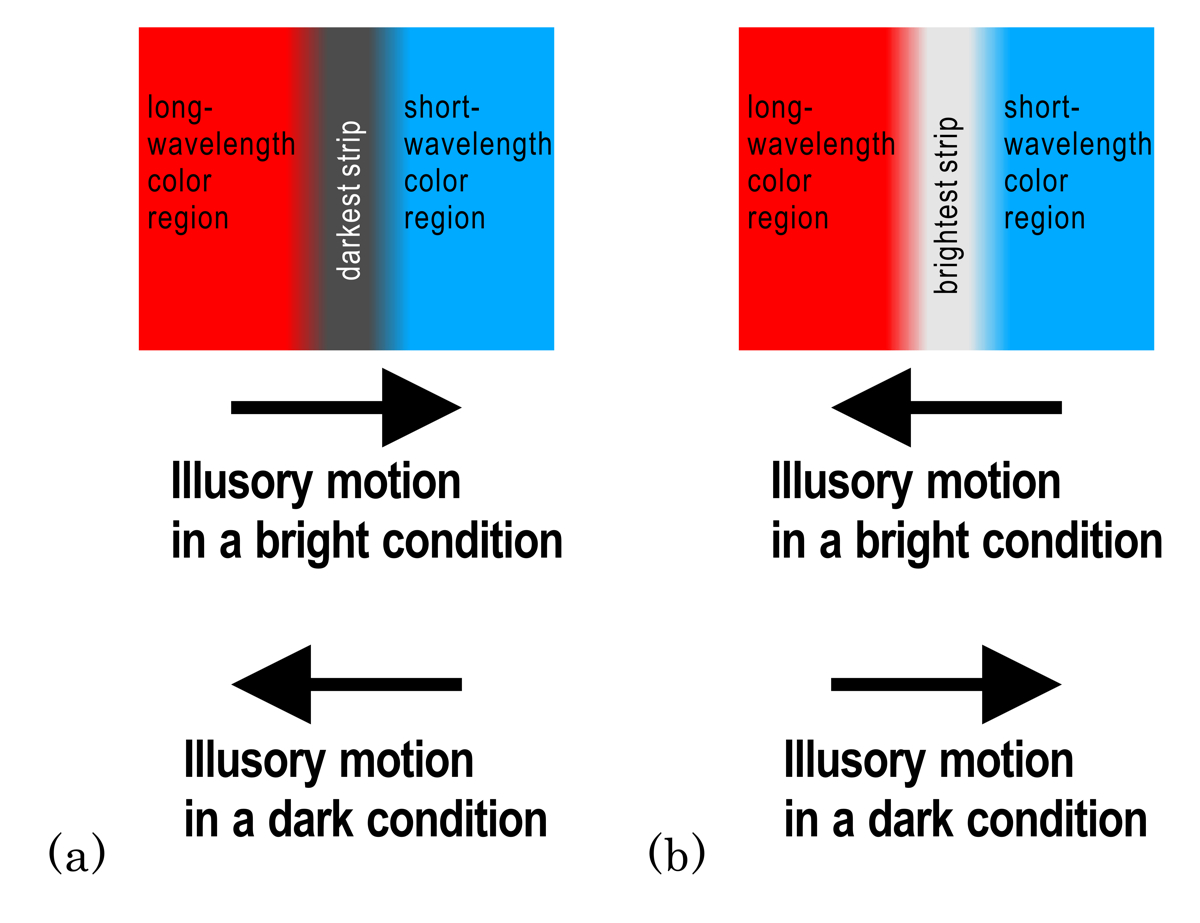
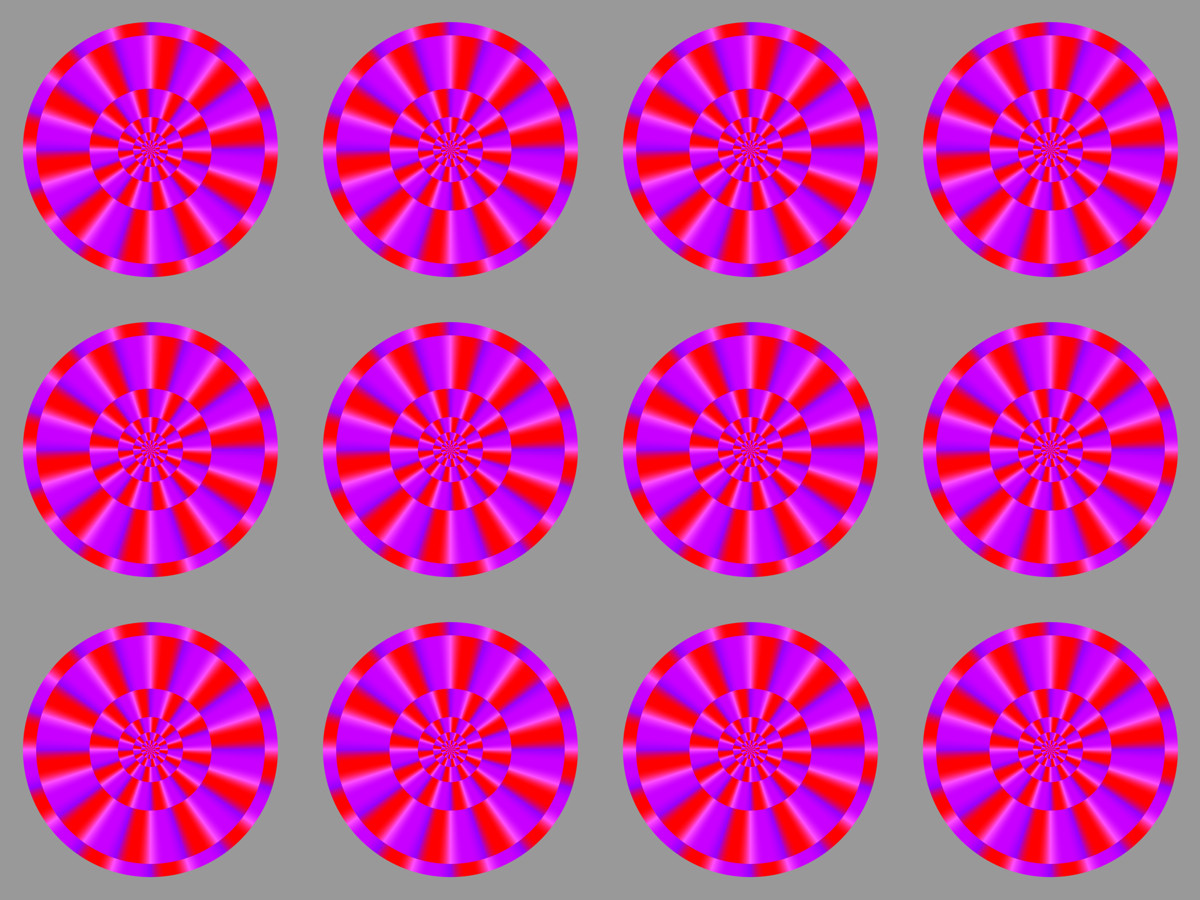
「赤と紫の円盤の回転」
明るいディスプレーでは円盤は時計回りに回転して見える。印刷物を暗いところで見ると反時計回りに回転して見える。
Copyright Akiyoshi Kitaoka 2013 (February 6)
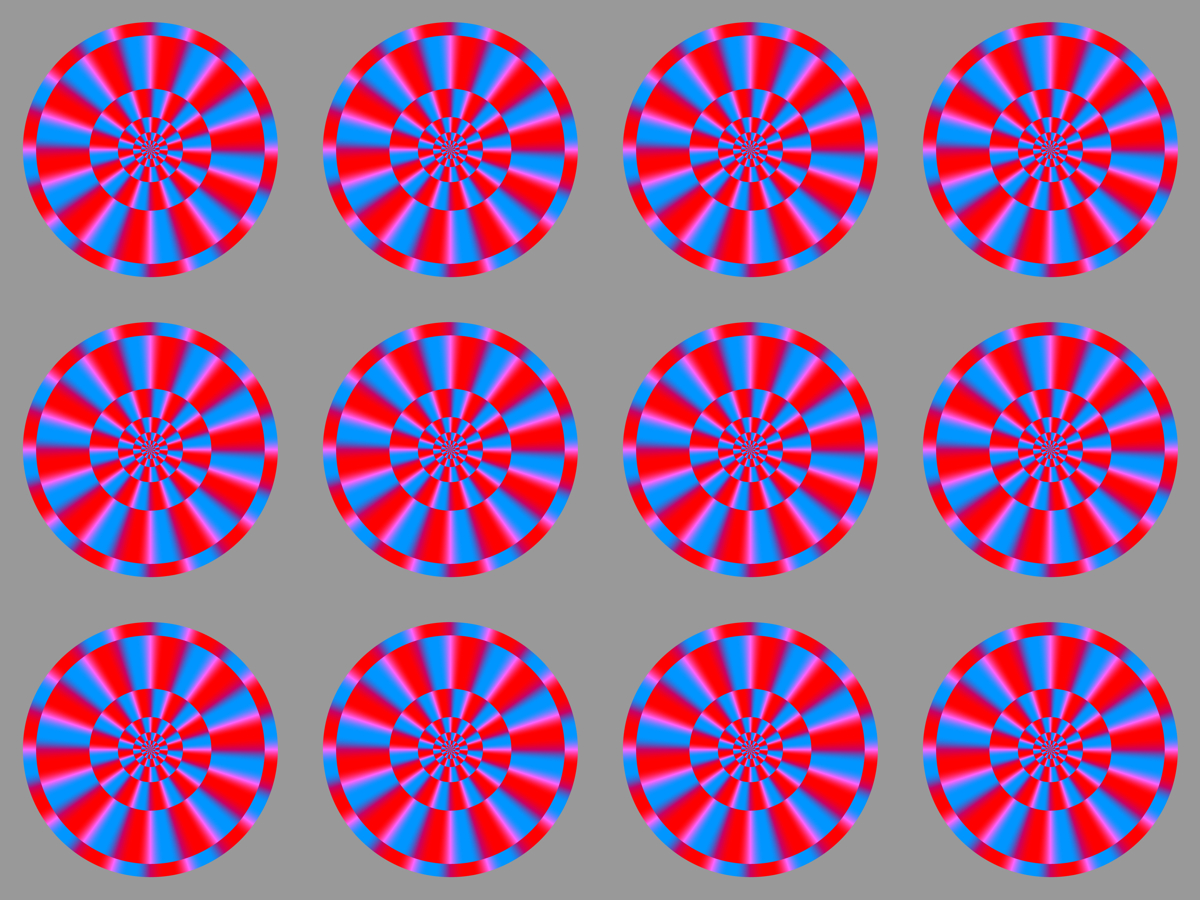
「赤とシアンの円盤の回転 3」
明るいディスプレーでは円盤は時計回りに回転して見える。印刷物を暗いところで見ると反時計回りに回転して見える。
Copyright Akiyoshi Kitaoka 2014 (January 27)
Dark type
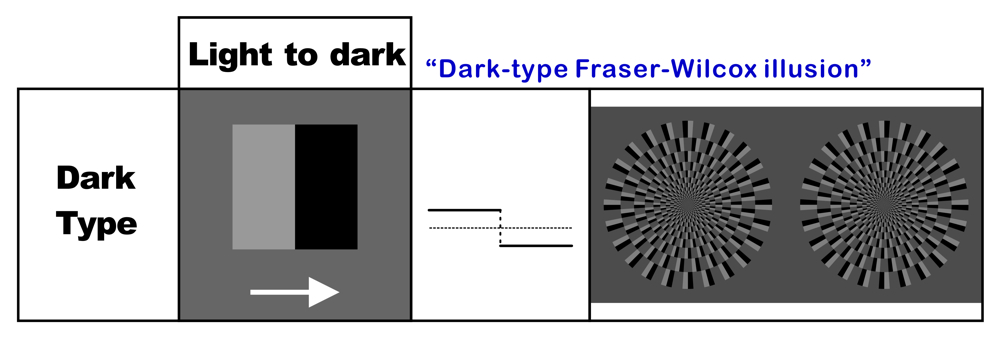
<Example> The upper-left, upper-right, and lower-middle disks appear
to rotate counterclockwise while the rest clockwise.
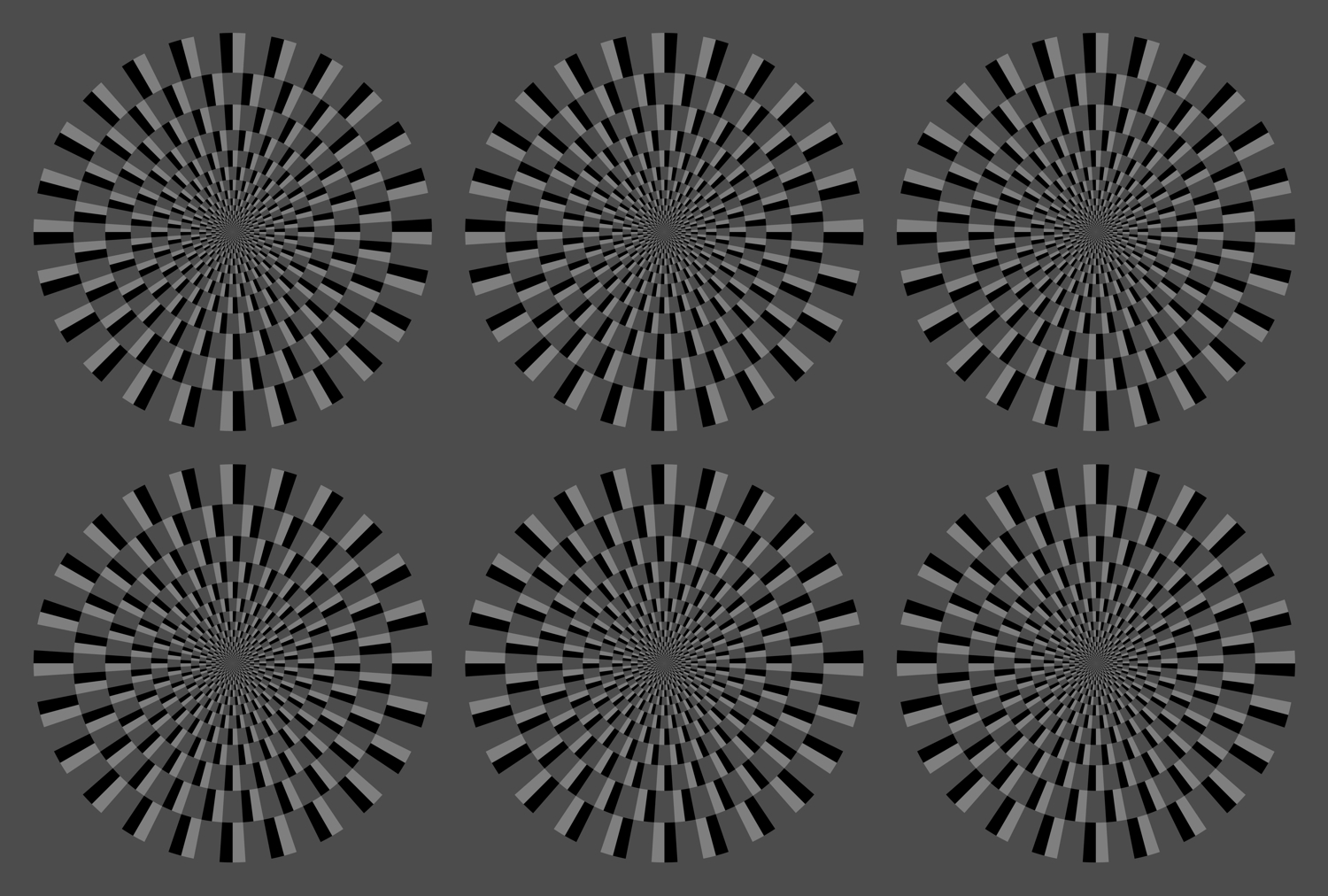
Kitaoka, A. (2012). The Fraser-Wilcox illusion and its extension. Perception 41 ECVP Abstract Supplement, page 91 (Poster September 3, 2012). Poster PDF
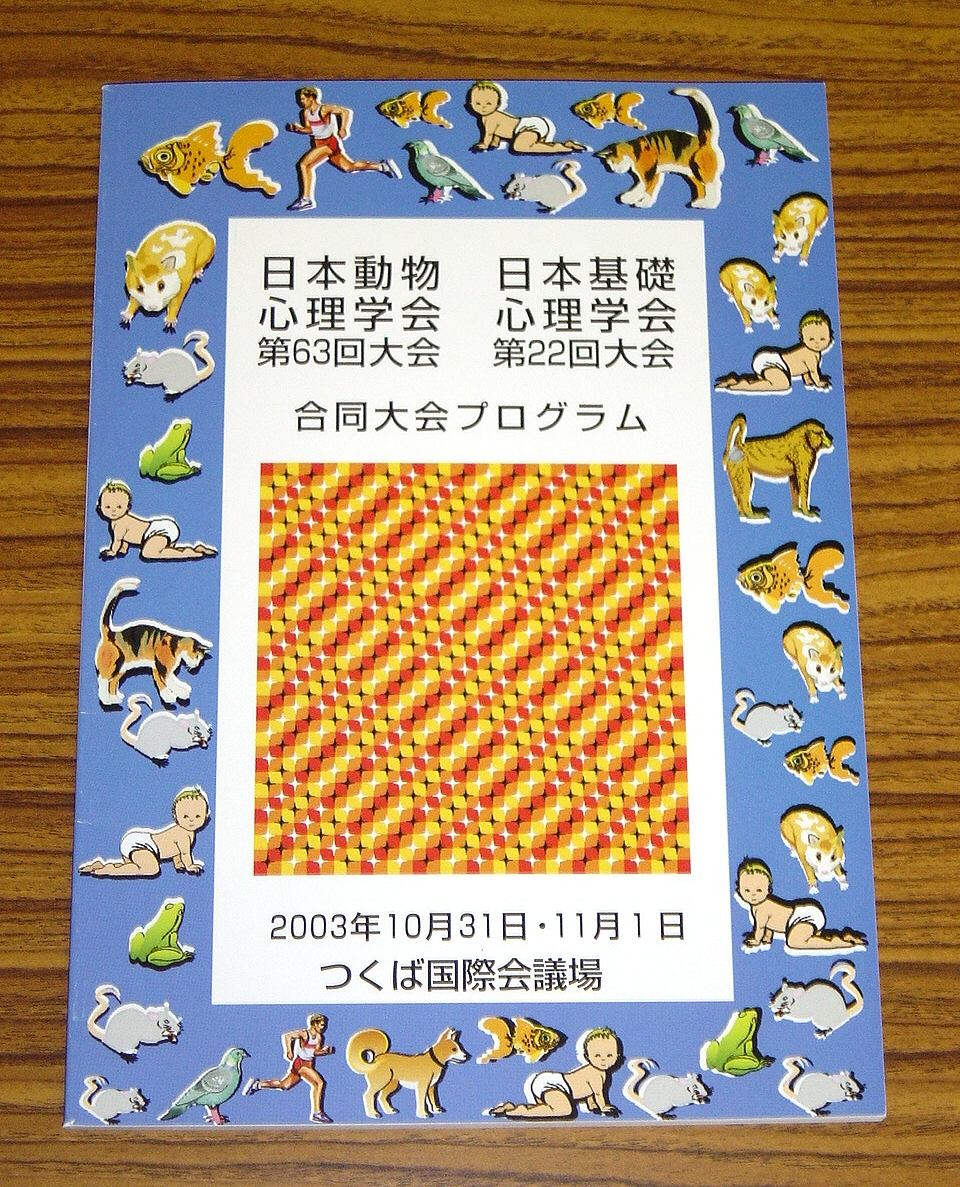
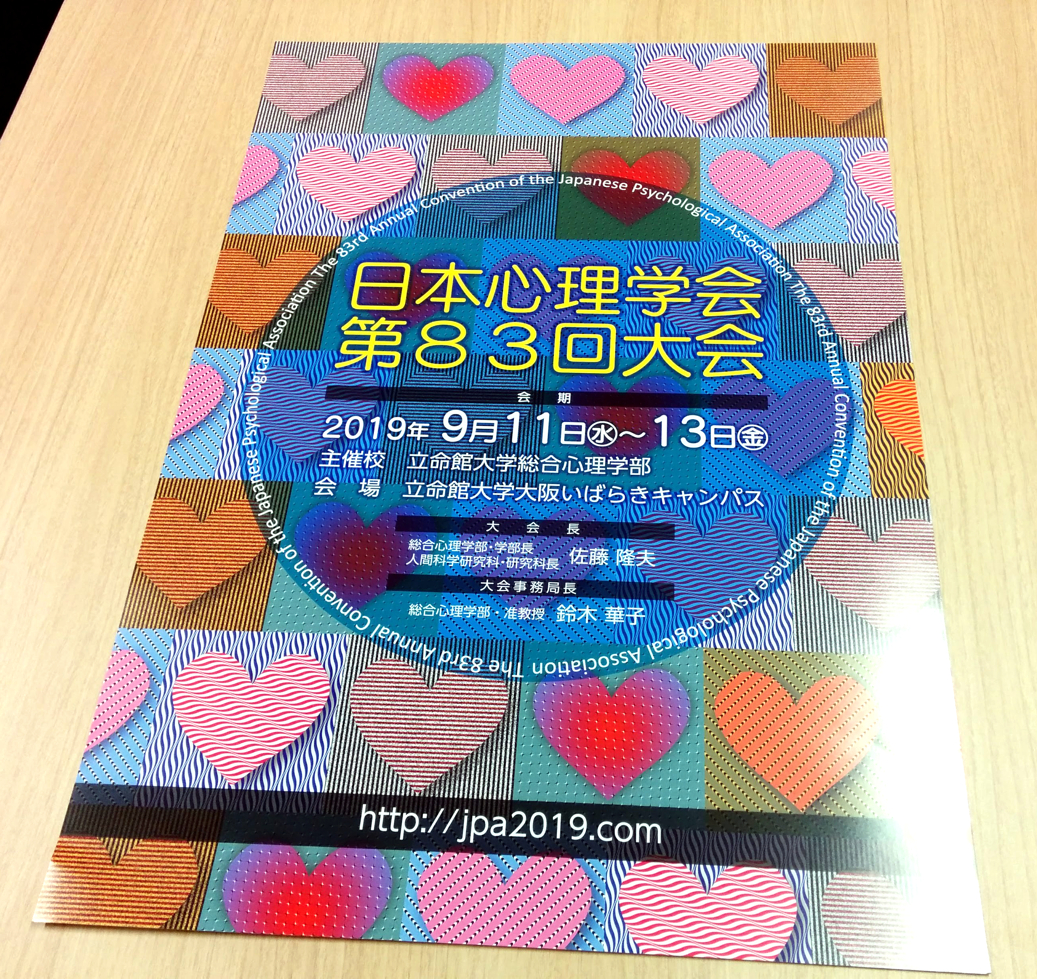
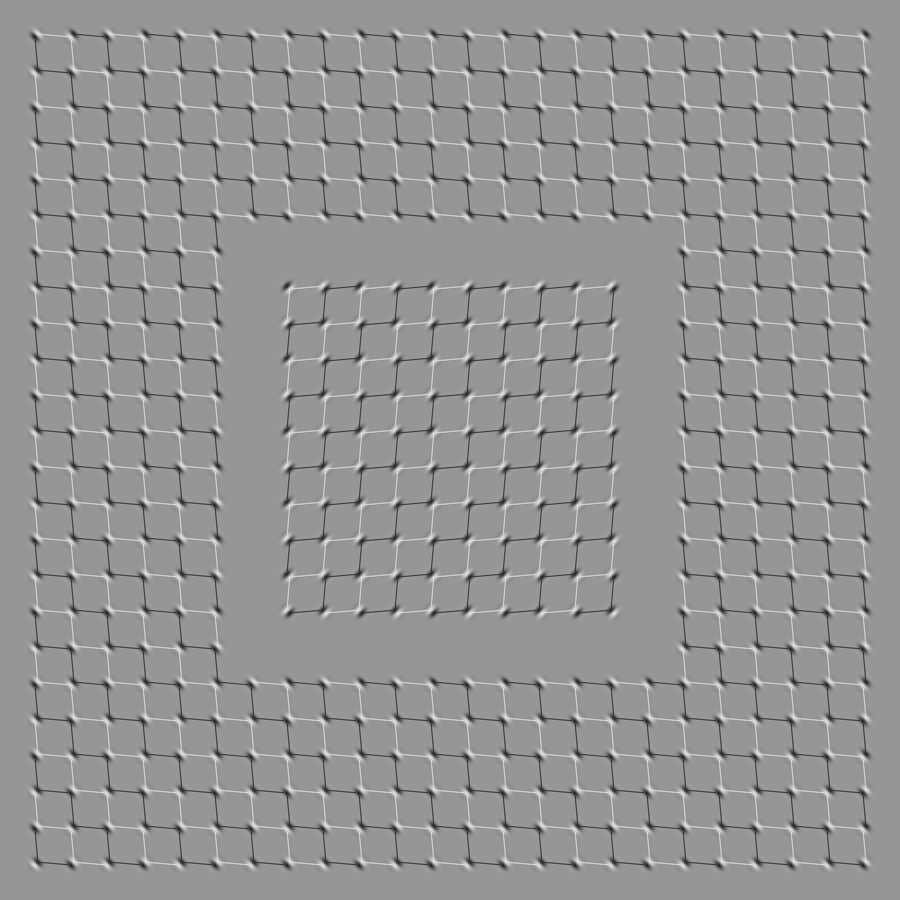
「エンボスドリフト錯視」
(サイン波型)
内側の正方形領域が動いて見える。
"Drifting Emboss illusion"
(sine type)
The inset appears to move.
Copyright Akiyoshi Kitaoka 2016 (February 15)
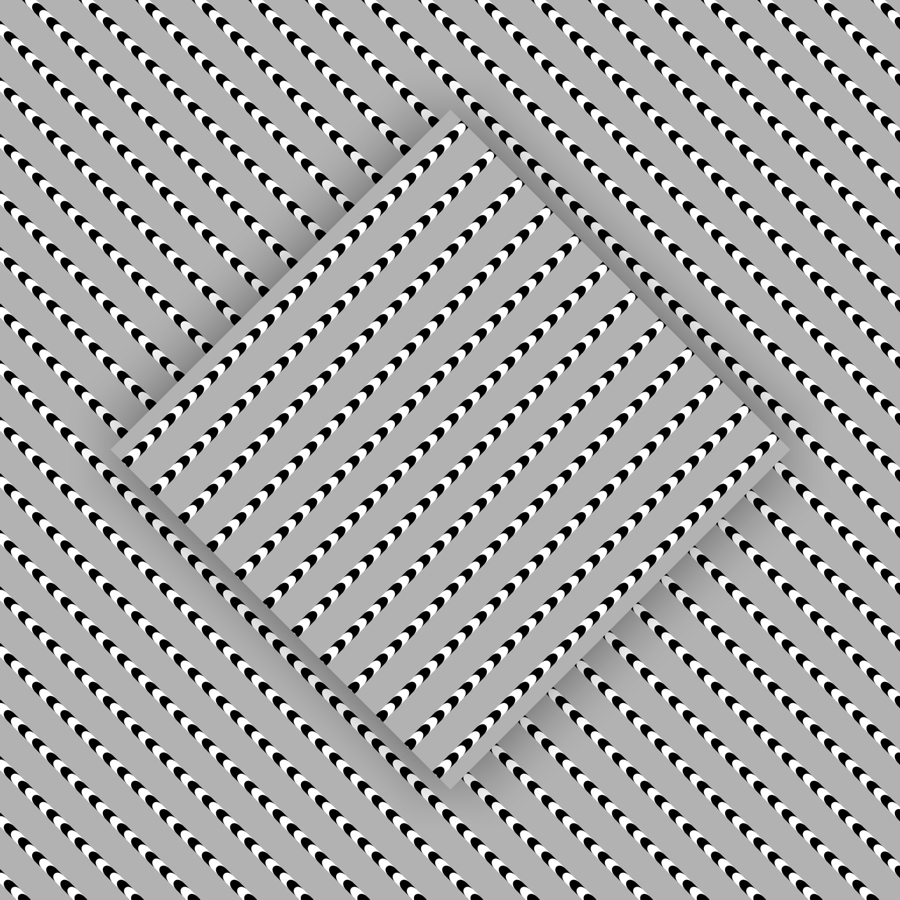
シマシマガクガク錯視
北岡明佳 略歴
1961年(昭和36年) 高知県高知市生まれ。
1961年~1966年(?) 香川県丸亀市に居住。
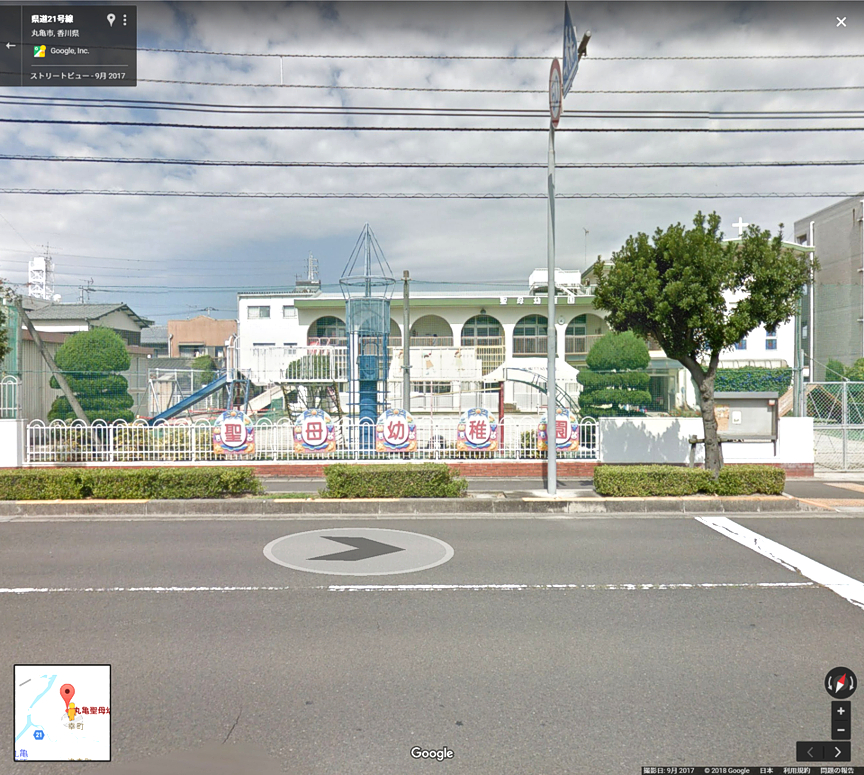
善通寺市の透明に見える山
山が透明に見える。
手前の山は「筆ノ山」(ふでのやま)、奥の山は「我拝師山」(がはいしやま、がはいしざん)と思われる。
Copyright Akiyoshi Kitaoka 2013 (August 1) 香川県善通寺市・高松自動車道善通寺インターチェンジ付近にて。撮影日は 2013年7月31日(水)

上記写真をトレースした結果 ↓
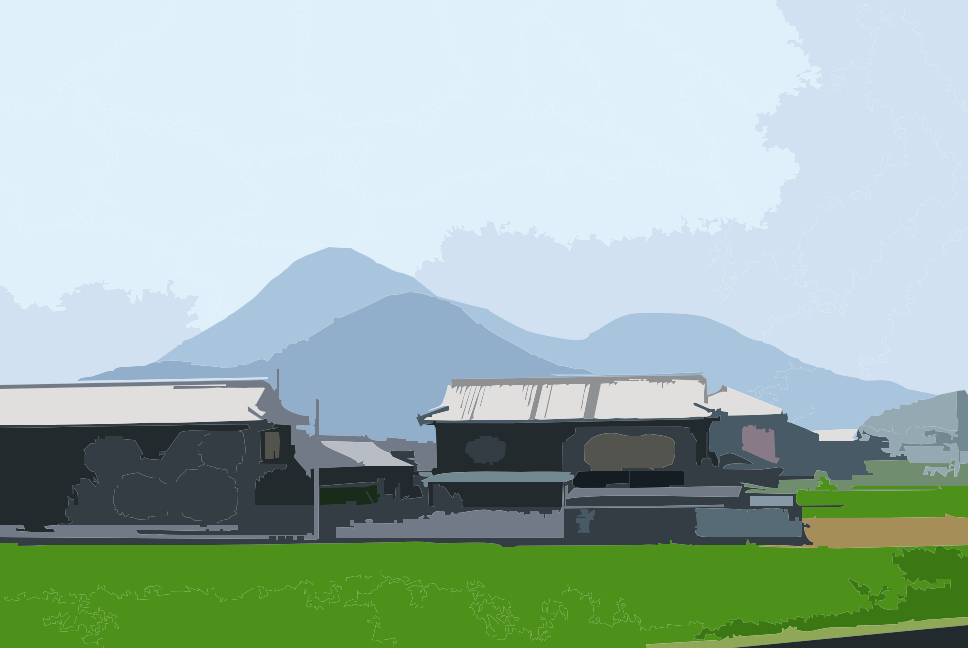
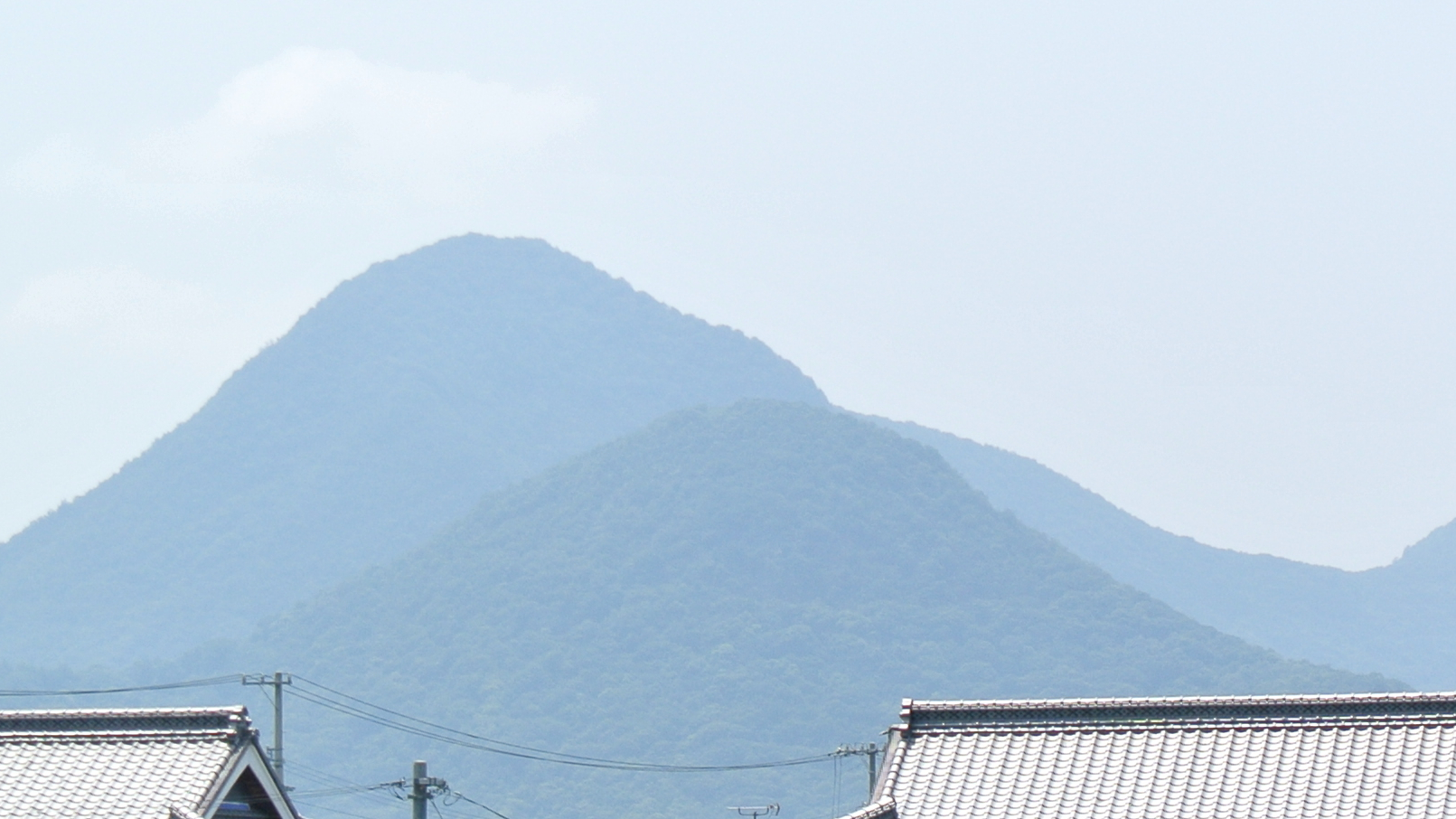
拡大するとバレバレ


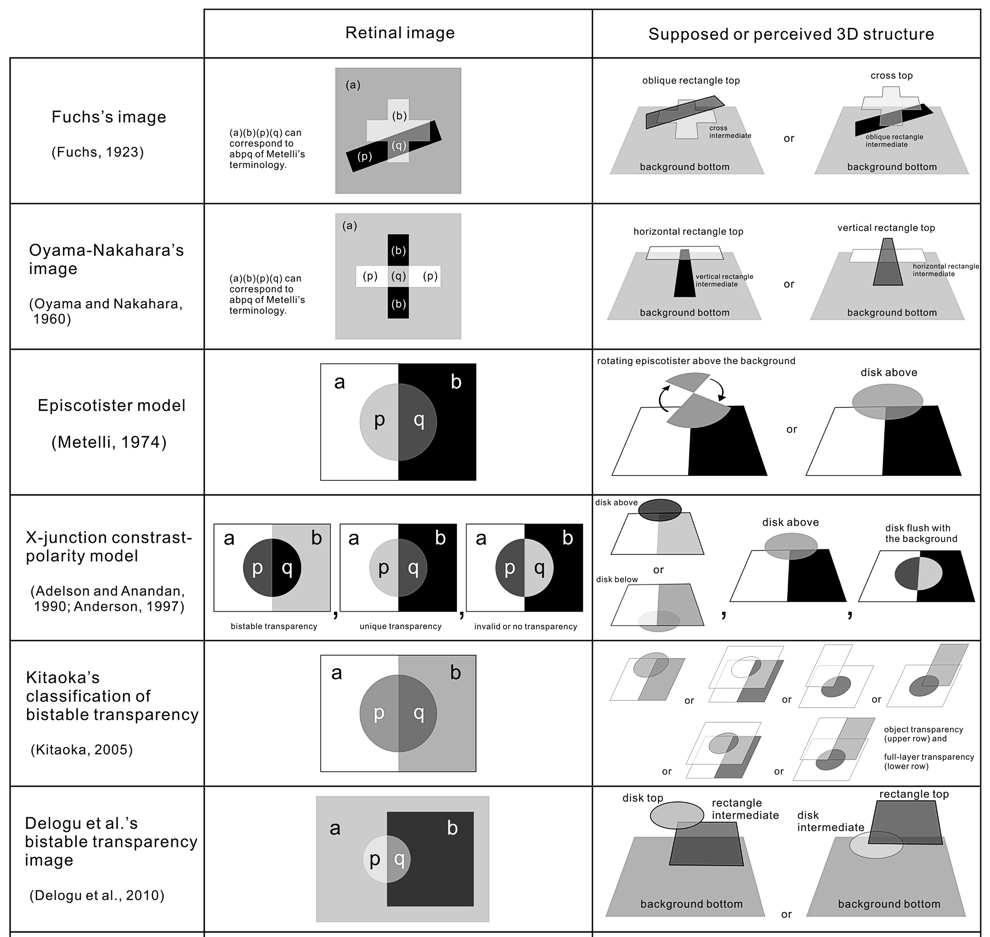
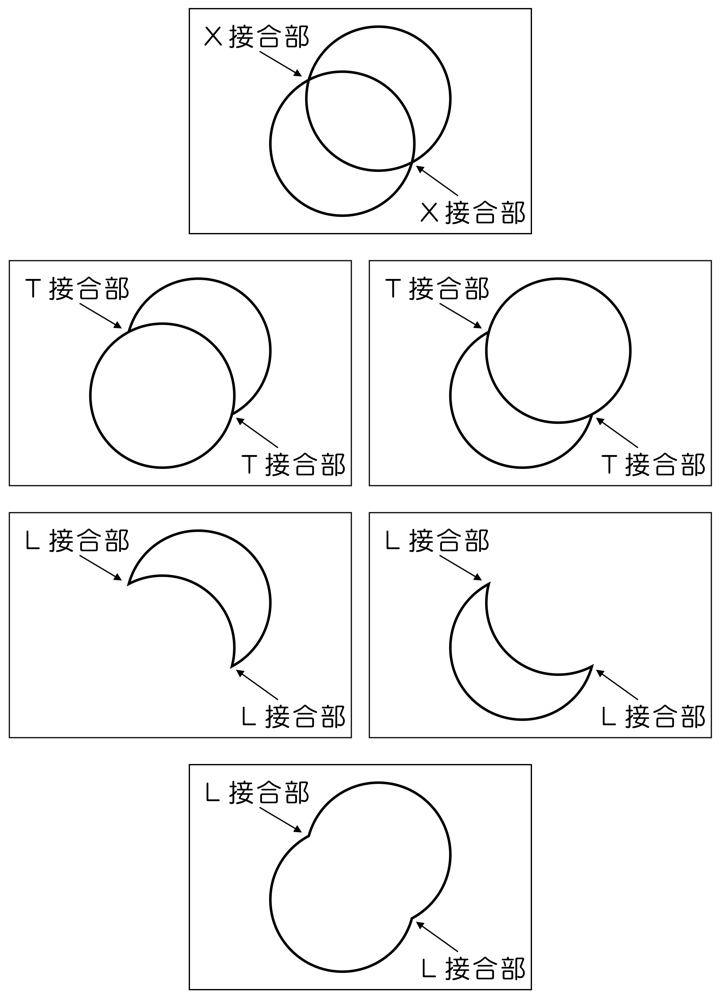
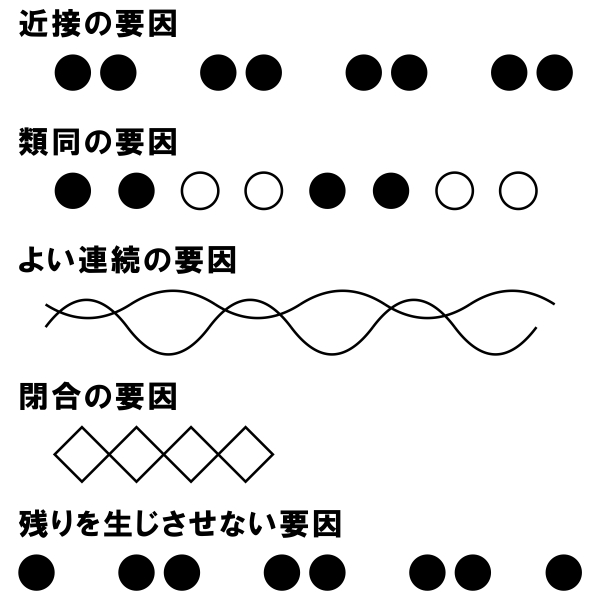
ゲシュタルト要因の例
1966年(?)~1976年(?) 高知県高知市に居住。
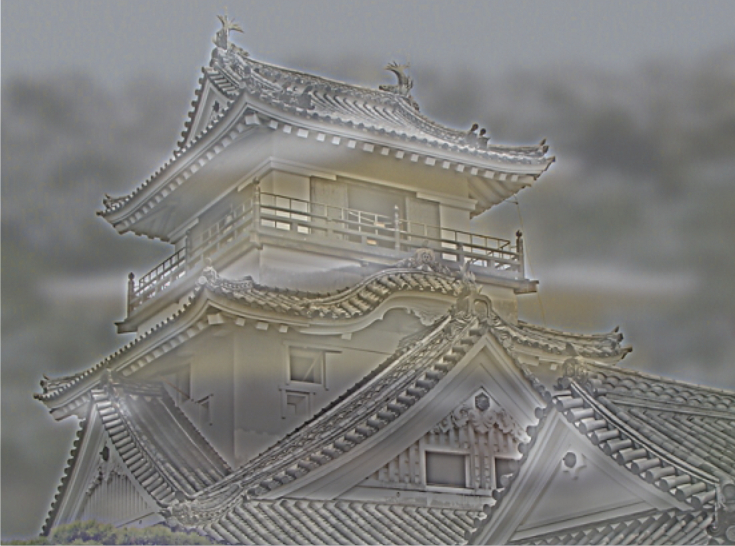
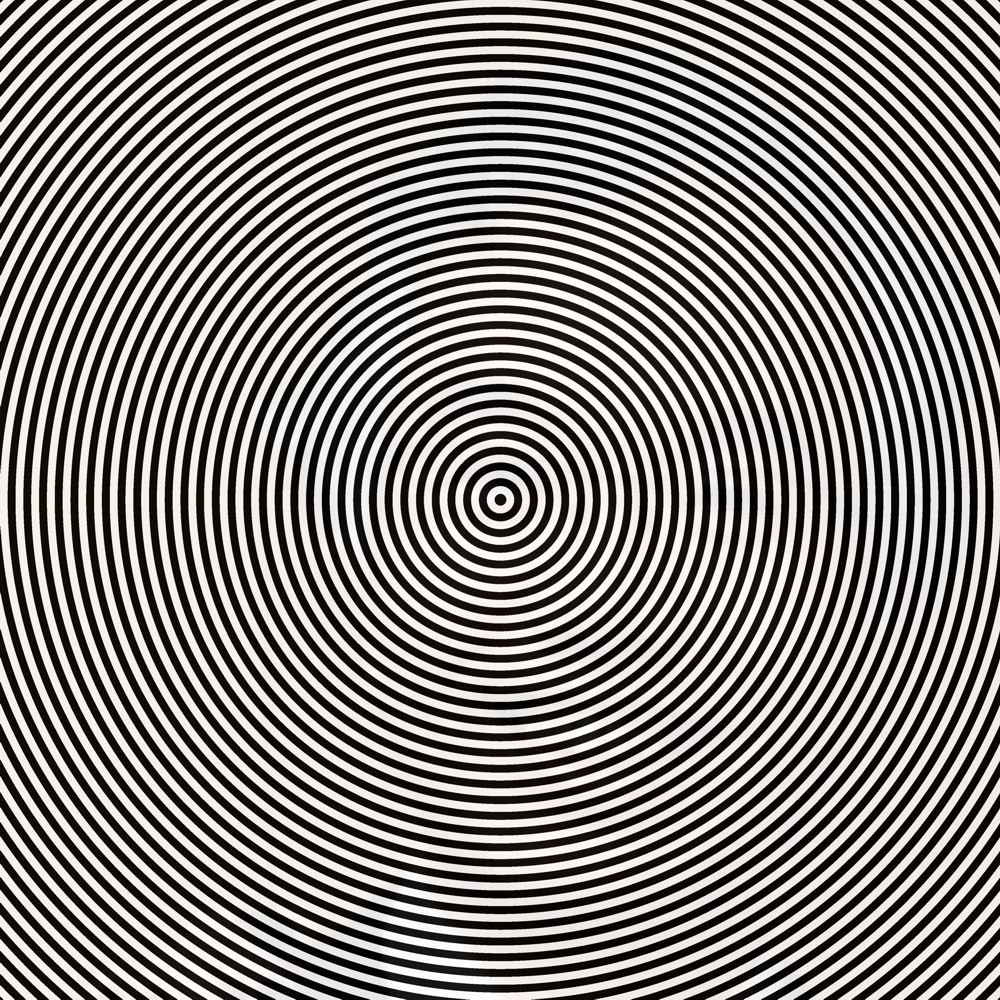
「なかなかわからない北岡 2019」
北岡が見えるかも。
Copyright Akiyoshi Kitaoka 2019 (January 30)
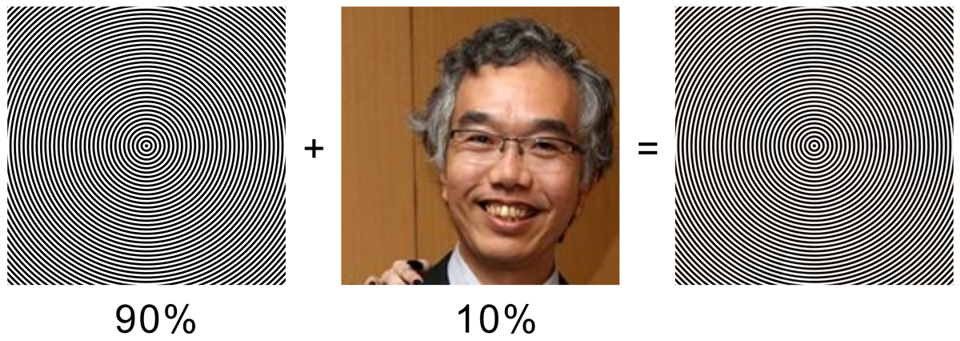
Copyright Akiyoshi Kitaoka 2019 (March 2)
作り方はアルファブレンディング(画像を加重平均)。
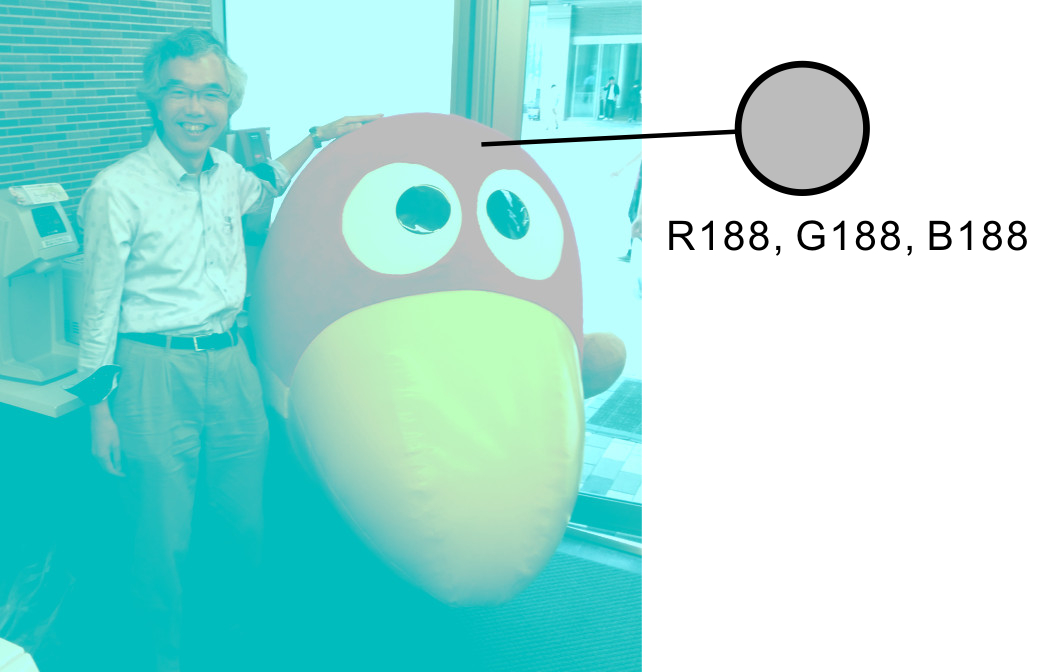
"Akiyoshi Kitaoka and Kyoro-chan (mascot of a chocolate snack)"
The head of the bird appears to be reddish, though the pixels are not.
Copyright Akiyoshi Kitaoka 2019 (February 24)
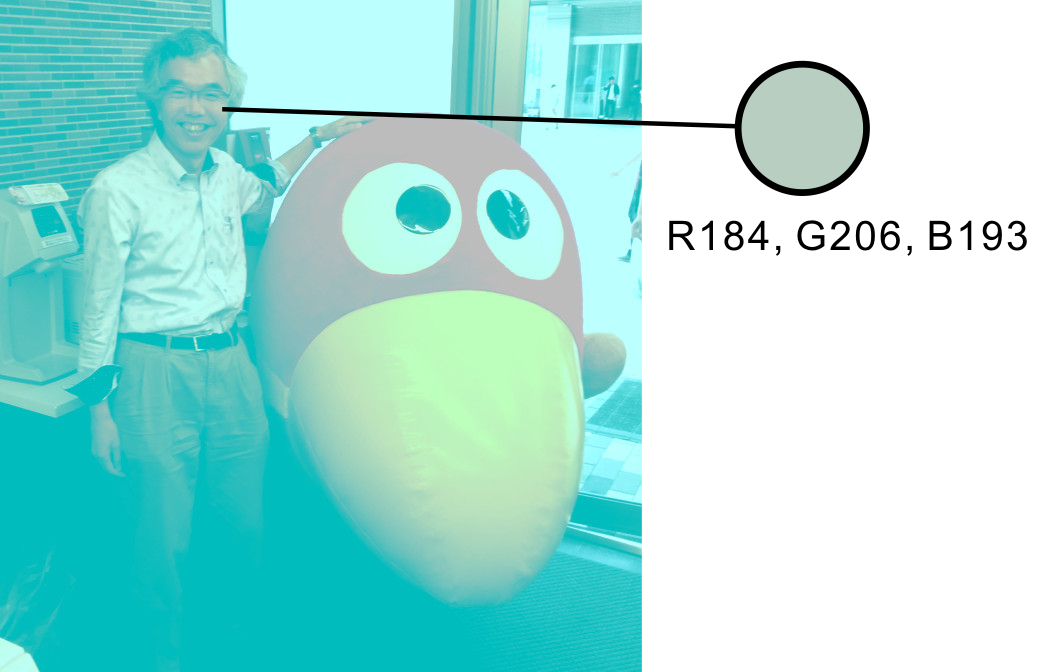
"Akiyoshi Kitaoka and Kyoro-chan 2"
My face appears to be reddish, though the pixels are greenish.
Copyright Akiyoshi Kitaoka 2019 (February 24)
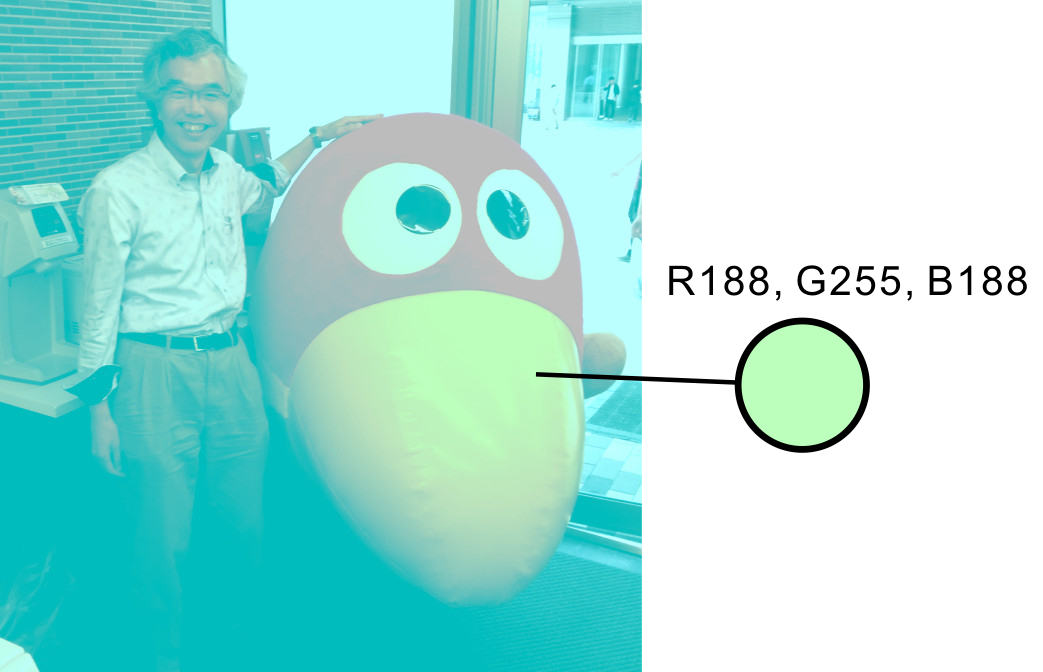
"Akiyoshi Kitaoka and Kyoro-chan 3"
The beak of the bird appears to be yellowish, though the pixels are greenish.
Copyright Akiyoshi Kitaoka 2019 (February 24)
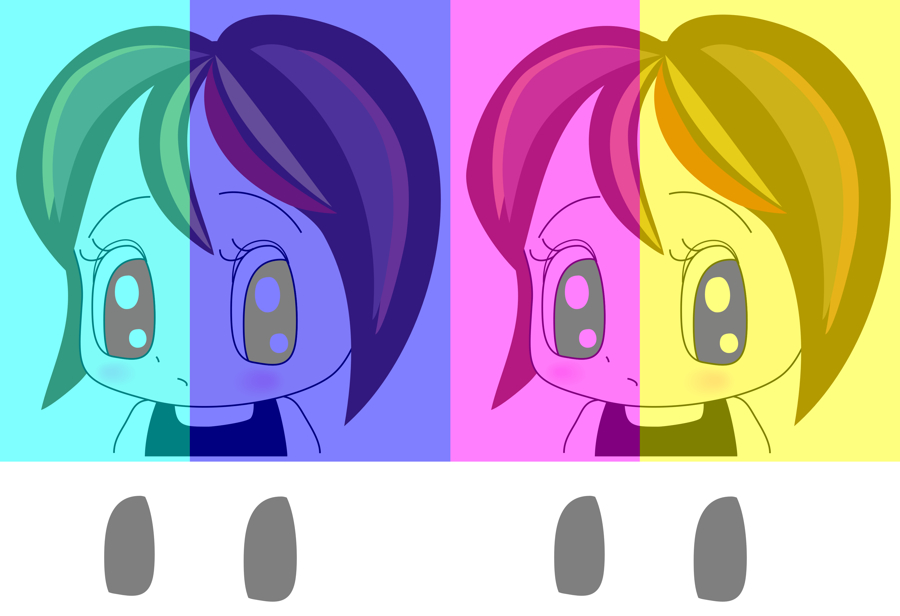
「RGBで白と黒」
Eyes appear to be reddish, yellowish, greenish and bluish, though they are gray as shown below.
左から、赤・黄・緑・青の目に見えるが、ほぼ同じ灰色である。
Copyright Akiyoshi Kitaoka 2017 (June 23) (updated on February 20, 2019)
加算的色変換による色の恒常性
Additive color change and color constancy
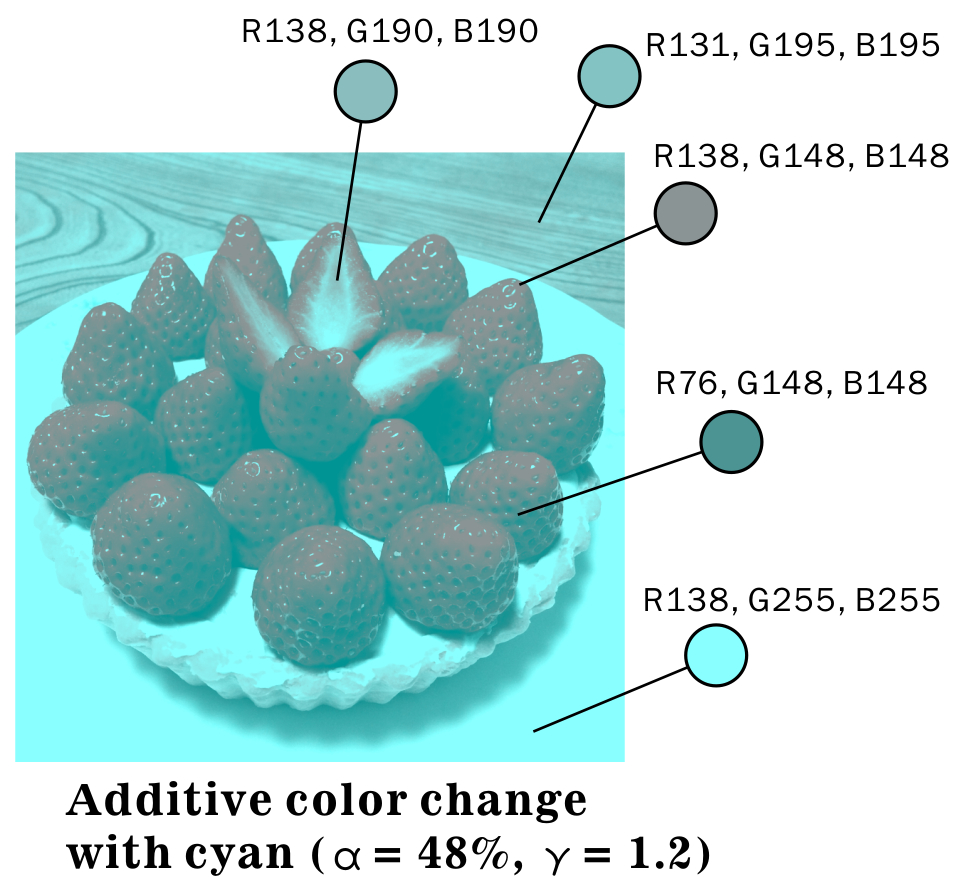
(γ = 1.2, α = .48)
Strawberries appear to be reddish, though each pixel is cyan hue.
Copyright Akiyoshi Kitaoka 2019 (February 20)
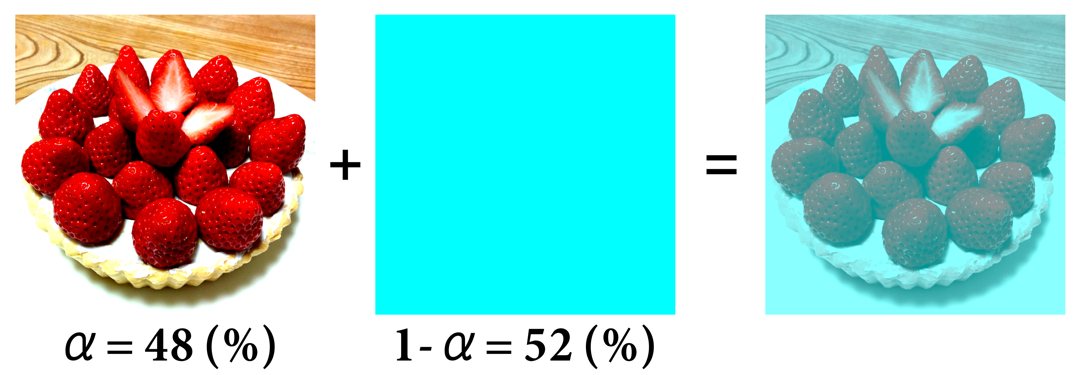
How to make a transformed image with alpha blending
Copyright Akiyoshi Kitaoka 2019 (February 20)
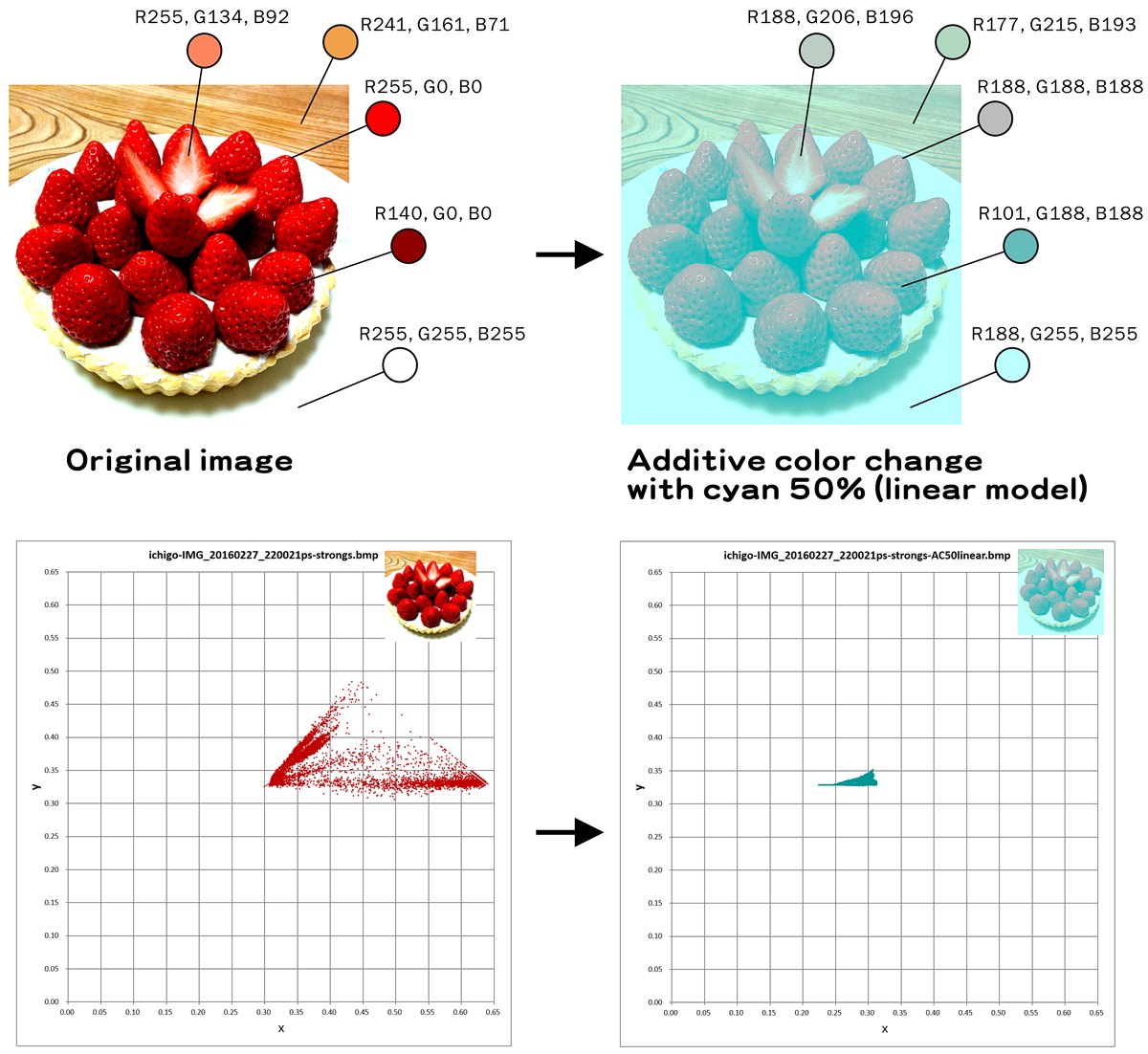
(with a CIE diagram)
Copyright Akiyoshi Kitaoka 2017 (March 15)
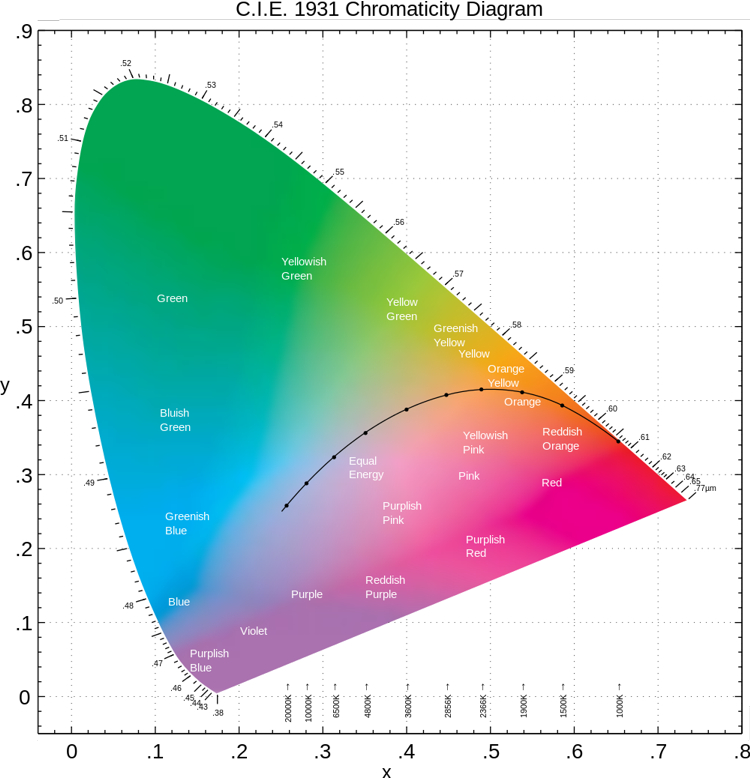
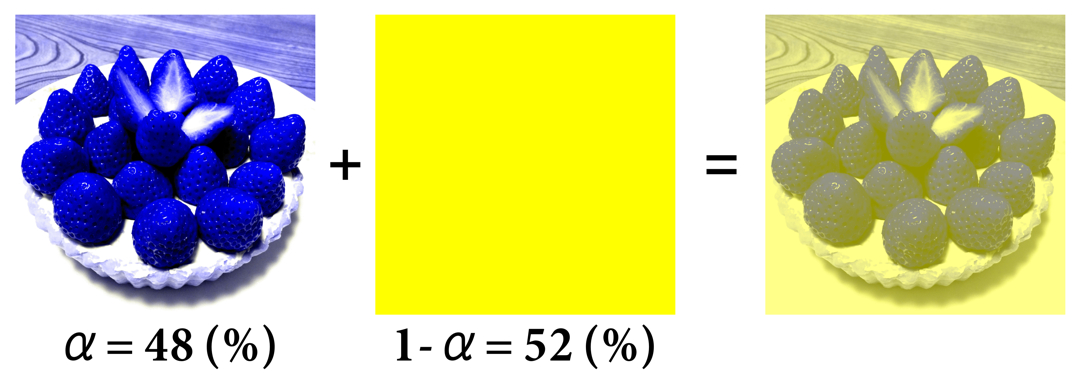
Strawberries appear to be bluish, though each pixel is yellow hue.
Copyright Akiyoshi Kitaoka 2019 (February 20)
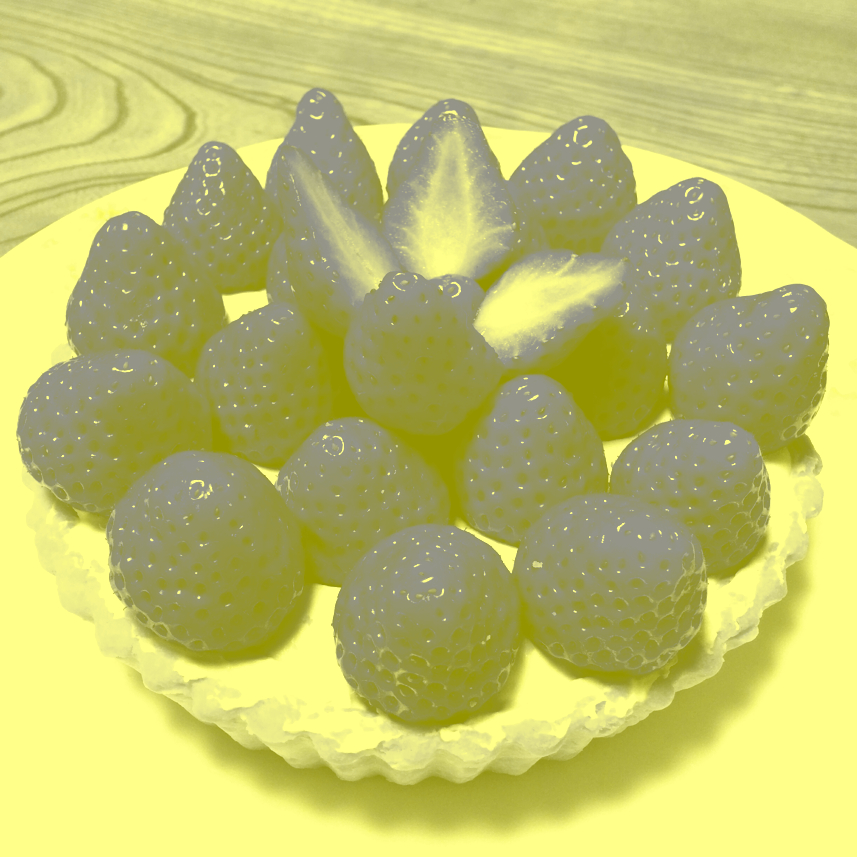
(γ = 1.2, α = .48)
Strawberries appear to be bluish, though each pixel is yellow hue.
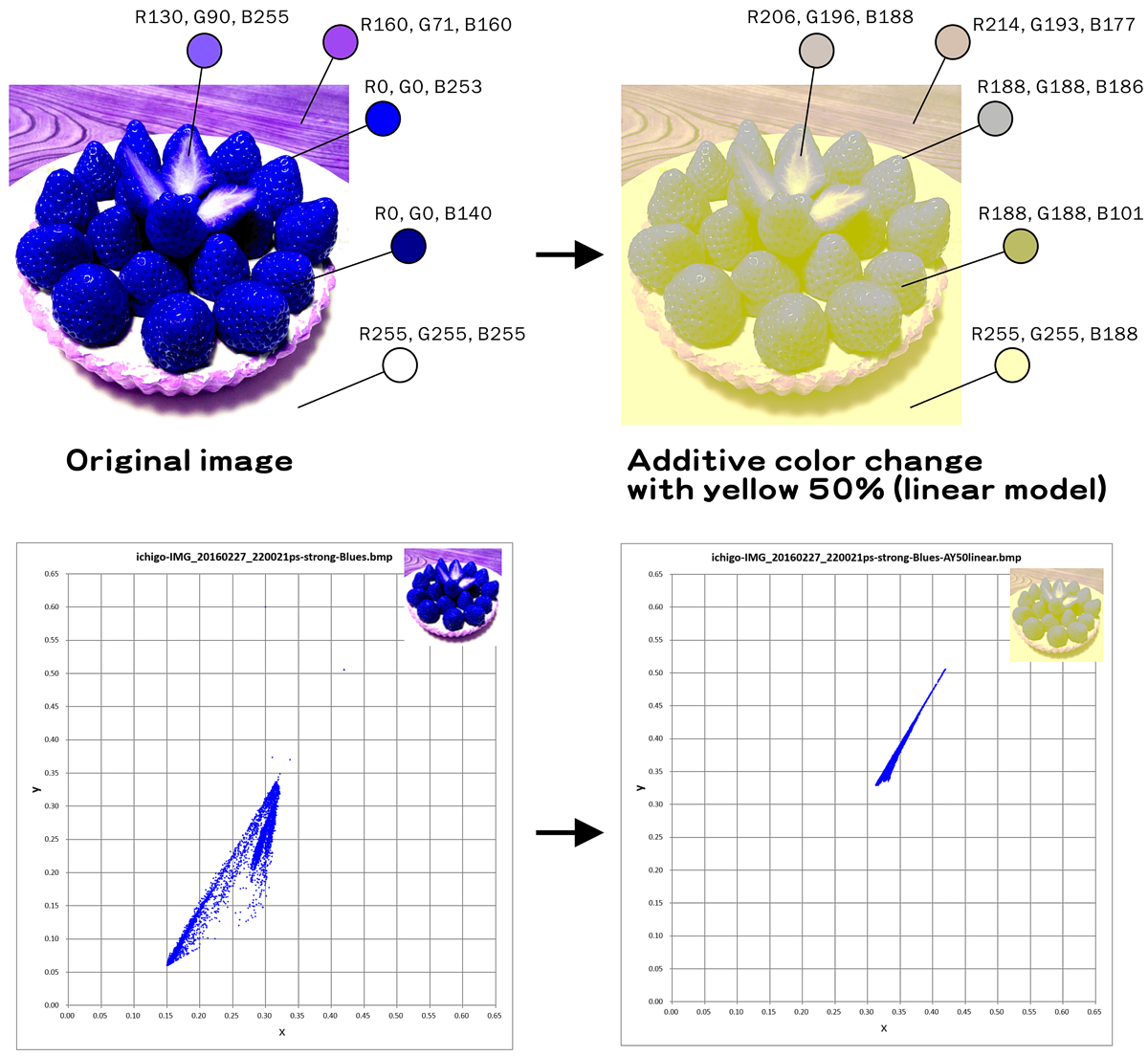
(with a CIE diagram)
1974年3月 高知市立江ノ口小学校を満期卒業
寺田寅彦は先輩である。銅像で会ったことがある。
1976年3月 高知県の進学校(?)の土佐中学校を中退!
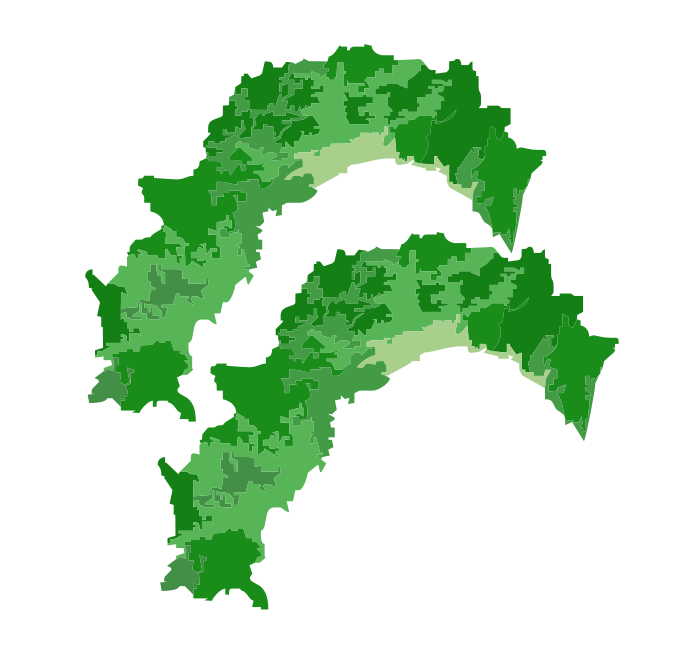
1976年4月 東京都の世田谷区立砧中学校に転校。東京キタ━(゚∀゚)━!
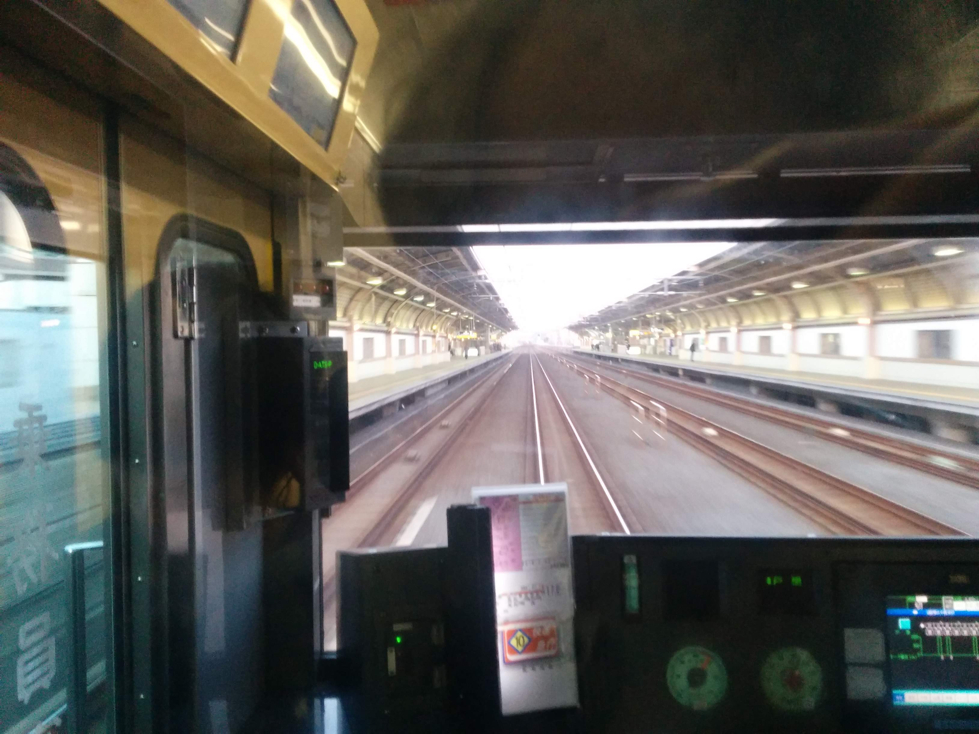
最近の小田急線千歳船橋駅(2019年2月17日)
1977年3月 東京都の世田谷区立砧中学校をわずか1年で卒業。これはもしかして早期修了?
1977年4月 東京都立青山高等学校に入学。

(写真はイメージです。写真はイメージに決まっていますが)
1980年3月 東京都立青山高等学校を満期卒業。
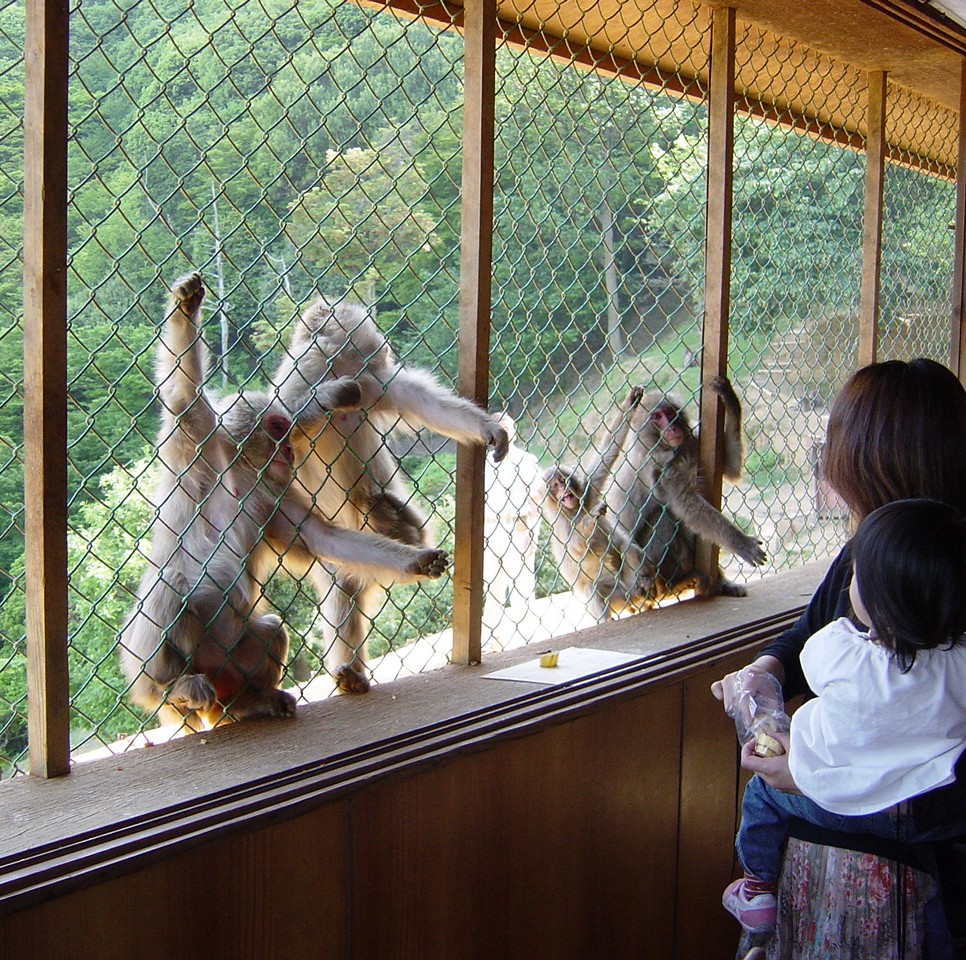
(写真はイメージです。写真はイメージに決まっていますが)
1980年4月 筑波大学第二学群生物学類に入学。本当は心理学をやりたかった。
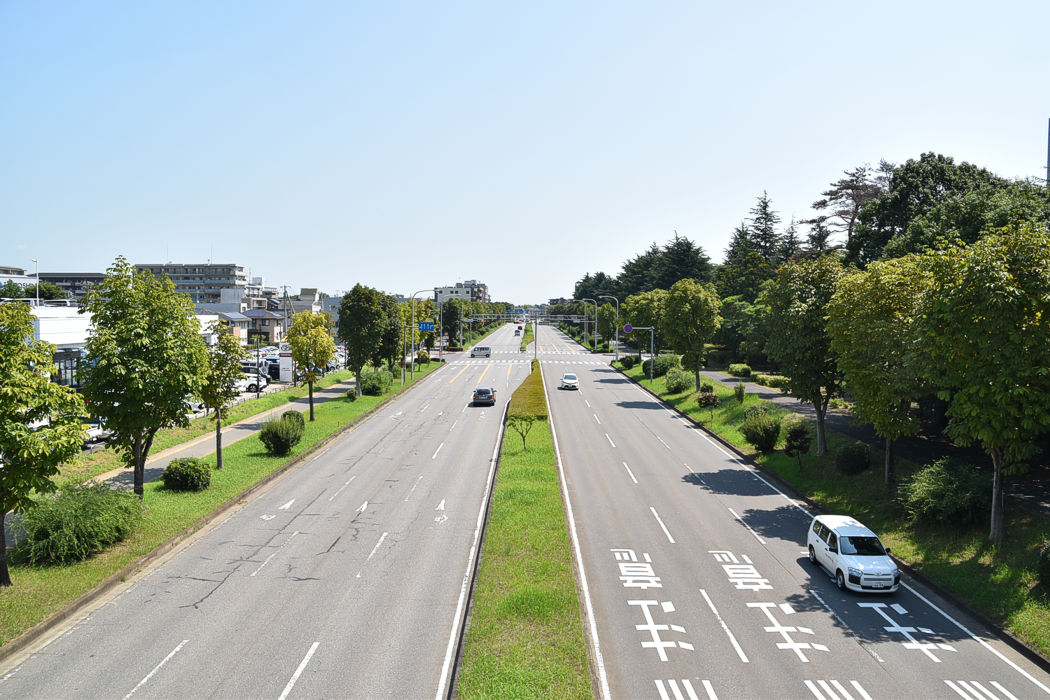
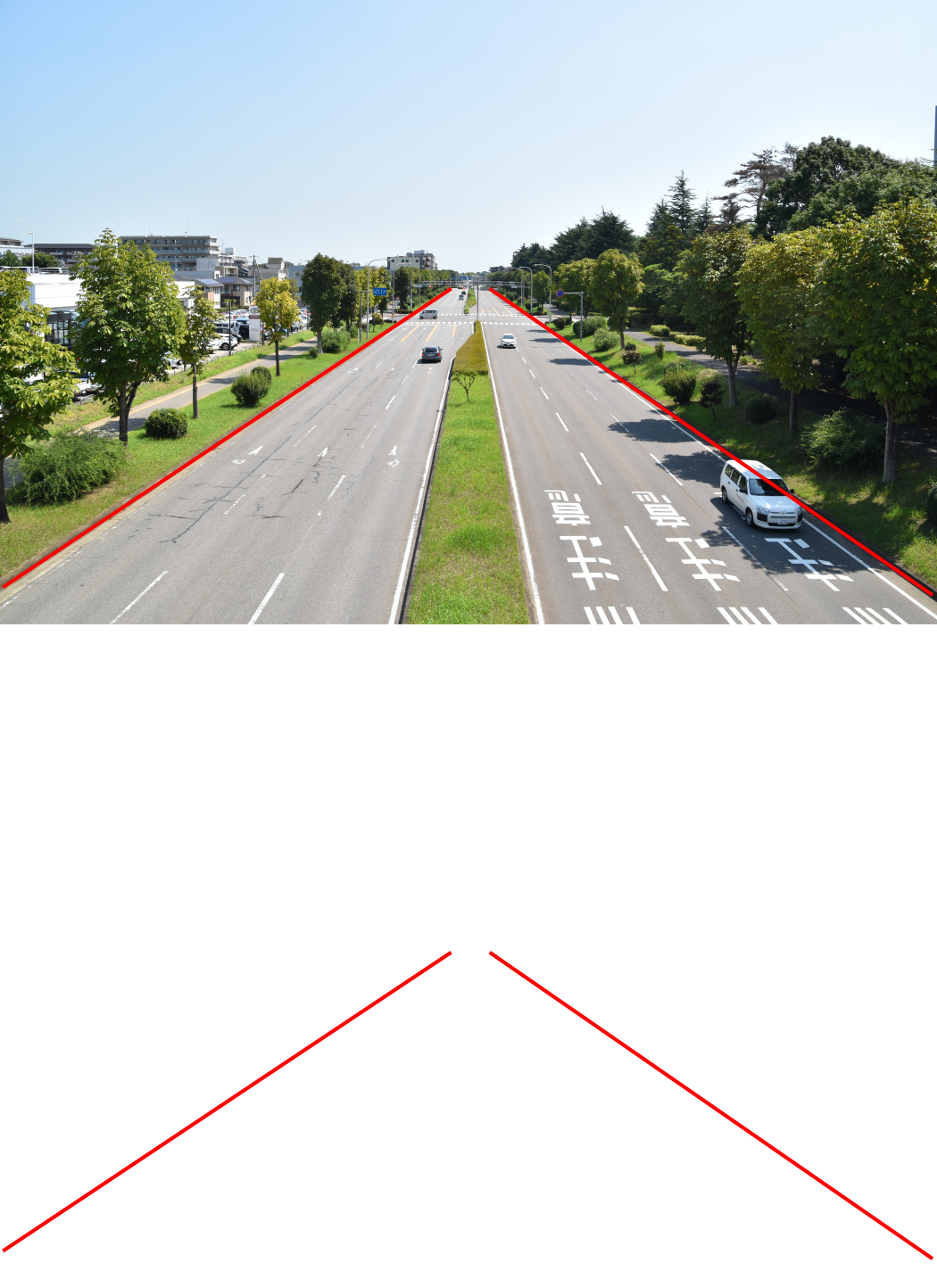
長錯視の例(車道の両端が成す角度が鋭角に見える場合)
1984年3月 筑波大学第二学群生物学類を満期卒業。
1986年4月 筑波大学大学院心理学研究科に入学。藤田統先生の指導院生となる。
研究テーマは、ネズミの穴掘り行動(burrowing behavior)であった。穴掘り行動は巣作りの一種のように思われていて、実際にメスがよく穴を掘るのであるが、オスも穴を掘ることを見出した。私は(というか藤田統先生の研究室は)、この穴掘り行動と情動性(emotionality)(臆病さ)が正に相関することを見出した(北岡, 1991; Kitaoka, 1994; Fujita, Annen and Kitaoka, 1994)。すなわち、パーソナリティの動物実験研究だった。
1991年3月 筑波大学大学院心理学研究科を修了。教育学博士を取得。
北岡明佳 (1991) 生態場面と実験室場面におけるラットの情動性の研究 教育学博士号取得論文(筑波大学) http://dl.ndl.go.jp/info:ndljp/pid/3093297(国会図書館デジタルコレクション)
<大学院時代の研究の原著論文>
北岡明佳・藤田統 (1988) ラットとマウスの穴掘り行動に及ぼす情動性・性・照明条件の効果 動物心理学年報,38, 93-106.
北岡明佳・藤田統 (1989) シェルター付きオープン・フィールドにおけるマウスの行動と「シェルター恐怖」 動物心理学年報,39, 1-11.
北岡明佳・藤田統 (1990) ランウェイ,オープン・フィールドおよびI迷路の3つの場面におけるラットの行動比較 心理学研究,61, 241-246.
Kitaoka, A. (1991). Emergence from home cage in rats (Rattus norvegicus) as a function of strain and sex. Japanese Journal of Animal Psychology, 41, 28-33.
Kitaoka, A., and Fujita, O. (1991). Behavioral comparisons of the Tsukuba Emotional strains of rats (Rattus norvegicus) in three types of novel situations. Behavior Genetics, 21, 317-325.
Kitaoka, A., and Fujita, O. (1991). A new type of soil material for a burrowing chamber for mice. Behavior Research Methods, Instruments, & Computers, 23, 348-350.
Kitaoka, A. (1994). Defensive aspects of burrowing behavior in rats (Rattus norvegicus): A descriptive and correlational study. Behavioural Processes, 31, 13-28.
Fujita, O., Annen, Y., and Kitaoka, A. (1994). Tsukuba High- and Low-Emotional strains of rats (Rattus norvegicus): An overview. Behavior Genetics, 24, 389-415.
Kitaoka, A. (1995). Effects of a shelter on open-field activity of rats (Rattus norvegicus) and mice (Mus musculus). Japanese Psychological Research, 37, 201-209.
1991年7月 東京都神経科学総合研究所に就職。
配属先は、「医学心理学研究部門」。サルを実験動物として用いた神経生理学的研究であった。職位は「主事研究員」。ヒラの研究員という意味である。しかし、内部では「技術員」と呼ばれており、建前上は自分の研究テーマを持てなかった。にもかかわらず、パーマネント職であった。
Thanks to 佐藤孝行先生。
1994年か1995年に、錯視研究を開始。
北岡明佳・佐藤孝行 (1999) カフェウォール錯視とその応用 日本人間工学会第29回関東支部大会講演集,
6-7. PDF(スキャンコピー)
Kitaoka, A. and Watanabe, J. (1998) Binocular stereopsis of transparent
figures. Selection and Integration of Visual Information: Proceedings of
the International Workshop on Advances in Research on Visual Cognition
(supported by Science and Technology Agency and National Institute of
Bioscience and Human Technology), 265-268.
北岡明佳・佐藤孝行 (1998) 注意依存性ステレオキャプチャ 電気通信大学大学院・ISシンポジウム-Sensing
and Perception, 5, 72-79. PDF(スキャンコピー)
北岡明佳 (1997) 錯視図形のオーバービュー VISION, 9, 131-162.
北岡明佳 (1996) 錯視研究への神経生理学的アプローチ-Münsterberg錯視等について- 第2回錯視コロキアム・プロシーディングス(ワークショップ「錯視研究への多様なアプローチ」報告),14-25.
(立教大学)
北岡明佳 (1995) 神経生理学的に見た幾何学錯視の意義 第1回錯視コロキアム・プロシーディングス,47-50. (都立大学)
2001年4月 立命館大学文学部に転職。
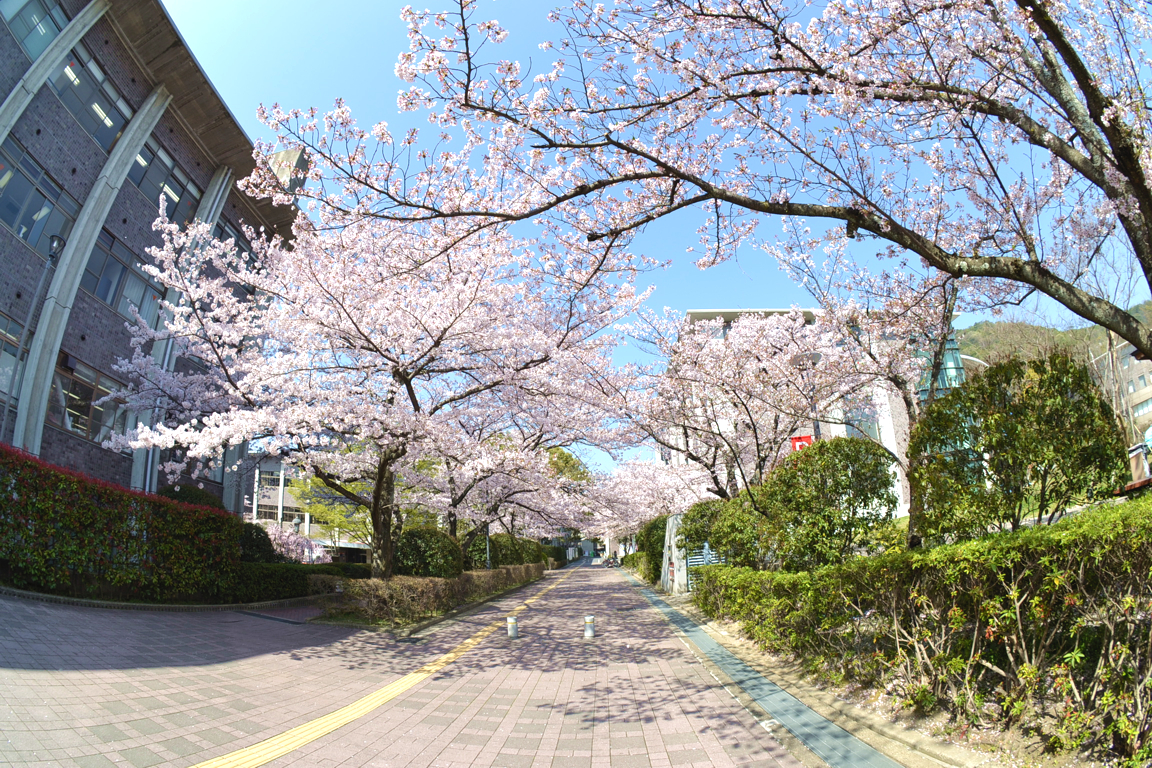
2002年7月 錯視のウェブサイトを開設。英語版も同時に開設。研究成果の発信媒体として活用。
2010年台になって、Facebook と Twitter を開設。研究成果の発信媒体として活用。
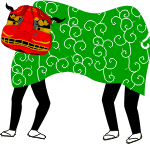 おしまい
おしまい


現在、私は立命館大学総合心理学部の知覚心理学の教員として、錯視の研究を進めている。錯視の研究だけでなく、錯視をデザインして、インターネットも活用して広報しているから、どこかで私の作品を見たことがある人は少なくないだろう。特に、静止画が動いて見える錯視と色の錯視の種類を増やし(要するにウケる錯視を増やし)、それらの作品を多く公開してきたことから、一般の人の錯視に対する関心を高めることに貢献できているのではないかと自己評価している。このように、私の仕事はうまいこといっているわけであるが、もともと私は知覚心理学の研究者だったわけではない。大学院では動物心理学だったのである。ネズミの研究である。ラット(大きい方)とマウス(小さい方)の両方である。ちなみに、パソコンのマウスは、ラットとマウスの中間くらいの大きさである。研究テーマは、ネズミの穴掘り行動(burrowing behavior)であった。穴掘り行動は巣作りの一種のように思われていて、実際にメスがよく穴を掘るのであるが、オスも穴を掘ることを見出した。私は(というか藤田統先生の研究室は)、この穴掘り行動と情動性(emotionality)(臆病さ)が正に相関することを見出した(北岡, 1991; Kitaoka, 1994; Fujita, Annen and Kitaoka, 1994)。すなわち、パーソナリティの動物実験研究だったのである。このように、なかなか筋のよさげな研究からスタートしたにもかかわらず、今は錯視研究の人として昔から知覚をやっているような顔をしているのはなぜなのかということを、錯視研究の試行錯誤の話などを織り交ぜつつ、ぼちぼち語ってみたい。